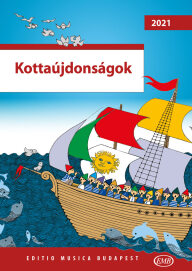Composers, works, events
Hesperus by Bella in Budapest
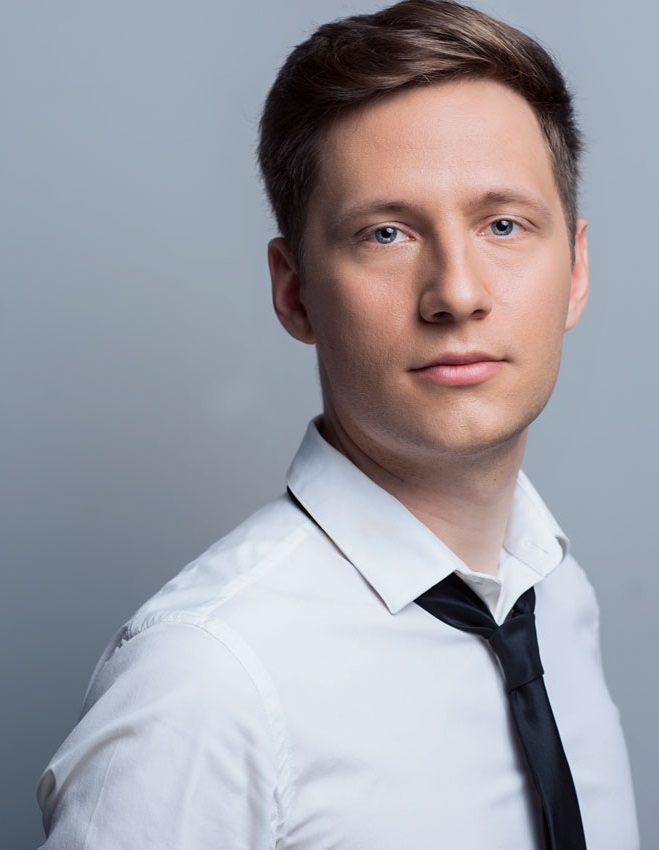 In 2017, Máté Bella composed his work Hesperus for viola and ensemble. The work was commissioned by the Ensemble Intercontemporaine and premiered on 16 February 2019 on French Radio. On May 18, Péter Bársony will be the soloist of the Hungarian premiere at the Budapest Music Center, the UMZE ensemble will be conducted by Gregory Vajda. We asked the composer on the occasion of this coming performance.
In 2017, Máté Bella composed his work Hesperus for viola and ensemble. The work was commissioned by the Ensemble Intercontemporaine and premiered on 16 February 2019 on French Radio. On May 18, Péter Bársony will be the soloist of the Hungarian premiere at the Budapest Music Center, the UMZE ensemble will be conducted by Gregory Vajda. We asked the composer on the occasion of this coming performance.
What kind of compositional ideas have you realized in Hesperus?
This piece is the third one in a series: First, Chuang Tzu’s Dream was written for cello and ensemble, then came Trance for violin and ensemble, and finally, Hesperus for viola and ensemble joined them. These compositions are actually concertos, and I am mainly interested in this genre to present the possibilities of the solo instrument as colourfully as possible. The ensemble draws a polyphonic background behind the solo instrument as if to display the shadow of the soloist, and at the same time, it acts as a kind of echo that takes over and transforms musical elements from the soloist.
Photo: VivienNaomi Photography
Was there any direct inspiration?
There were several: In 2016, I heard Mark Andre’s orchestral piece hij 1 in Switzerland: a huge apparatus on stage that sounded very softly all the time. I was strongly impressed by this sound and was looking for something similar in Hesperus. At the same time, as the title suggests, Hesperus seeks to evoke the flickering of the Evening Star, a visual impression, by acoustic means. It was also important to me that in darkness our ears are more sensitive to the noises of the environment, and that’s why I strived for a kind of silky sound and also for the piece to be very quiet all way long, except for a brief dynamic climax. I’ve long been concerned with transformation processes between noises and musical sounds. In Hesperus, we arrive at musical sounds from the noises and then back at the noises. My string orchestra piece Lethe is just going the other way round, from musical sounds to noises and back.
To what extent was the character of the work determined by the capabilities of the solo instrument?
Before writing the play, I consulted Péter Bársony, who will now be the main figure of the Hungarian premiere. I remember one of his first sentences was this: Remember that the viola is an alto instrument whose deep register, mostly its C-string, sounds beautiful, and it’s not good to fall into the fault of those who want to use the higher registers melodically. I took this warning and decided that I would use the higher registers mainly as harmonics. Accordingly, I designed the viola part so that during the piece it sinks from the high harmonics to the C-string and then rises high again. This arc contrasts the accompaniment’s way from noises to musical sounds and then back to noises.
György Kurtág at 95
 “Every note he writes is essential. There is never an idea of small talk. There is never an idea of wanting to please somebody or an audience. For him, there is only the truth, the essential, that you never can lie when you make music.” – That’s how Heinz Holliger recently summed up the life and work of his friend and fellow musician György Kurtág who soon turns 95. Holliger’s short, considered statements echo Kurtág’s notoriously aphoristic musical style.
“Every note he writes is essential. There is never an idea of small talk. There is never an idea of wanting to please somebody or an audience. For him, there is only the truth, the essential, that you never can lie when you make music.” – That’s how Heinz Holliger recently summed up the life and work of his friend and fellow musician György Kurtág who soon turns 95. Holliger’s short, considered statements echo Kurtág’s notoriously aphoristic musical style.
“You never come too late” – said Kurtág once, referring to his slow, meticulous working method. He dates his mature composer career from 1958 when after one year stay in Paris, he returned to his Hungarian isolation behind the iron curtain being aware of his task of life, and, as he put decades later, “that outward circumstance cannot influence what is now happening to me.”
This more than sixty-year-old notion is valid even today since Kurtág follows unshakably his own path. The fame of his unique musicality as a composer and as a teacher first has been revealed only for a small circle of Hungarian enthusiast. Sayings of Péter Bornemisza remained unnoticed in Darmstadt in 1968. Not so the premiere of the Messages of the Late R. V. Troussova fifteen years later in Paris, recorded under the baton of Pierre Boulez. And since then the camp of the Kurtágians has gradually grown to uncountable. Even if the centre of his output is unalterable, the musical manifestations are astoundingly varied: from aethereal to vulgar, from gentle to cruel, from menacing to grotesque. The common feature in this whole spectrum is that the gestures always communicate in a direct and unambiguous manner.
As a copestone of seventy years of composing, Kurtág delivered his Beckett-opera, Fin de partie, that he finished after seven years of work. “The final masterpiece of twentieth-century music,” that’s how Axel Ross labelled it after the 2018 Milan premiere. The opera comprises an encyclopedia of Kurtágian gestures but it also represents a through-composed dramatic process of two hours.
Since this premiere Kurtág, the nonagenarian hasn’t stopped composing: new piano pieces, short vocal compositions leave his workshop regularly. UMP Editio Musica Budapest, his principal publisher for six decades now, celebrates his forthcoming 95th birthday with the release of 10th volume of Játékok (Games), that contains besides piano pieces written between 2002 and 2011 also a couple of compositions from the 1940s-1980s, giving an exceptional insight into Kurtág’s workshop in his earlier years.
Preparing new editions and revisiting old ones means a continual exchange with him, an exciting challenge and a constant learning process, both in a professional and personal sense. We wish him, and ourselves, and the entire music world that this relationship continue for a long time.
the UMP Editio Musica Budapest team
On the Centenary of András Szőllősy
 "The third master" - his faithful monographer, János Kárpáti used this epithet on András Szőllősy who was born on February 27, 1921, a hundred years ago. He was the third beside György Ligeti and György Kurtág, who were all born in Transylvania in the 1920s, and then graduated from the Budapest Academy of Music - that is, he was the third behind his world-famous colleagues and friends.
"The third master" - his faithful monographer, János Kárpáti used this epithet on András Szőllősy who was born on February 27, 1921, a hundred years ago. He was the third beside György Ligeti and György Kurtág, who were all born in Transylvania in the 1920s, and then graduated from the Budapest Academy of Music - that is, he was the third behind his world-famous colleagues and friends.
Szőllősy’s oeuvre is thin, consisting of barely thirty compositions, mostly from the 1970s and 1980s, followed by a few “autumn flowers” until 2002. The late start of the career is explained by the fact that although Szőllősy studied composition as a student of Zoltán Kodály, he felt more like a musicologist until the mid-1960s, collecting and editing the works and writings of his great predecessors, Béla Kodály and Bartók. (his Sz-numbers are still used to identify Bartók's works).
A fresh impetus for composing came at the commission of the renowned flautist Severino Gazzelloni in 1964 (Tre pezzi). It is rumoured that with this cycle, Szőllősy wanted to show his younger colleagues, enchanted by the avant-garde of Western Europe, that he also has an independent idea of the modern tone. The real breakthrough was Concerto no. 3, for string orchestra, written in 1968, which was chosen as Distinguished Composition of the Year at the 1970 UNESCO Rostrum in Paris. Concerto No. 3 already carries the features of Szőllősy’s style of the following decades: a strict structure, a very precise notation that gives the impression of aleatory, but at the same time a retrained expression of an overall tragic worldview that appears in recurring intonations such as dirges, chorales, and bells, summoning the atmosphere of a funeral.
In the 1970s and 1980s, in addition to Hungarian orchestras, Szőllősy received commissions from renowned European institutions as the Dresdener Staatskapelle (Preludio, Adagio e Fuga), the BBC Wales (Canto autunno), the Dutch Ensemble M (Pro somno Igoris Stravinsy quieto) and the Berlin Biennale (Elegia). In the 1980s, vocal works brought a new colour, most notably compositions for King’s Singers, like Fabula Phaedri, a fine example of Szőllősy’s humour, and the touching Miserere.
His last works: two poignant funeral music, in memory of his youthful friend (Passacaglia Achatio Máthé in memoriam) and the always supportive musicologist-critic colleague (Addio: György Kroó in memoriam). As if Szőllősy himself were saying farewell in these compositions with the sound of string instruments, like decades before, when in Concerto No. 3 strings helped to find the composer’s own voice.
G. Ricordi & Co., New York sign visionary composers Michael Gordon, David Lang and Julia Wolfe to exclusive, global publishing deal

Photo: Peter Serling
Los Angeles, September 14, 2020 — G. Ricordi & Co., New York, a Universal Music Publishing Classical company, today announced an exclusive global publishing agreement with innovative American composers and Bang on a Can co-founders Michael Gordon, David Lang and Julia Wolfe. Under the new agreement, Gordon, Lang and Wolfe’s esteemed catalogs are now represented worldwide by Ricordi and its international partners.
This signing is the first for G. Ricordi & Co., New York, the newest member of Universal Music Publishing Group’s classical publishing operation and the first one in North America, joining its offices in Milan, Paris, Berlin, London and Budapest.
The trio join Ricordi’s world-class roster of leading composers from the past several centuries including Rossini, Verdi, Puccini, Varèse, Nono, Battistelli, Francesconi, Haas, Neuwirth and Poppe. Additionally, Universal Music Publishing Classical boasts the Durand, Salabert, Eschig and Editio Musica Budapest catalogs, which feature celebrated international composers such as Debussy, Ravel, Milhaud, Poulenc, Messiaen, Dusapin, Kodály and Kurtág.
“This is a defining moment for Ricordi and for the new-music landscape of North America, as Michael, David, and Julia are paradigm-shifting composers whose boundless creativity will continue to captivate audiences for generations to come,” said Jude Vaclavik, Director, US Publishing and Promotion for G. Ricordi & Co., New York. “We cherish this rare opportunity to join into a partnership with these iconic composers. It is an honor to be entrusted with their singularly important catalogs.”
Though their vision for the present and future of music is aligned, each composer contributes something unique to their collective musical tapestry. “Gordon is Bang’s resident experimentalist,” writes Alex Ross of The New Yorker, “drawn to densely roiling textures.”
Lang has become especially known for his music featuring voices, including a steadily growing catalog of innovative operatic works. Says Ross, “Anyone who clings to the prejudice that contemporary classical music is incapable of the most direct beauty should put down this magazine and go listen to the Theatre of Voices’ recording. If you never come back, I won’t blame you.”
William Robin of The New Yorker said, “Wolfe’s commitment to a pluralist populism—in both musical style and political content—may make her the most relevant Bang composer to the current moment. That democratic impulse also makes her an heir to the legacy of Aaron Copland, whose left-leaning politics guided his construction of an iconic American sound.”
MICHAEL GORDON
Michael Gordon is known for his monumental and immersive works. Gordon’s Decasia, for 55 retuned spatially positioned amplified instruments (that also serves as the soundtrack for Bill Morrison’s cult-classic film) has been featured on the Los Angeles Philharmonic’s Minimalist Jukebox Festival and at the Southbank Centre’s Ether Festival. Gordon’s Timber, a tour-de-force for percussion sextet, played on amplified microtonal simantras, has been performed on every continent including by Slagwerk Den Haag at the Musikgebouw (Amsterdam), Mantra Percussion at BAM (New York), So Percussion at the Barbican (London), Ictus at MaerzMusik (Berlin), and live on NPR from a Lowe’s hardware store. Timber has been remixed by Jóhann Jóhannsson, Oneohtrix Point Never and Squarepusher.
Gordon’s work employs the placement of instruments in an environment to create an enveloping mesmerizing spectacle. Natural History, for 120 musicians and the drummers of the local Klamath tribe, was premiered on the rim of Crater Lake (Oregon) by conductor Teddy Abrams and is the subject of the PBS documentary Symphony for Nature. Big Space, commissioned by the BBC Proms, premiered in the Royal Albert Hall with musicians surrounding the audience on all sides. Rushes, for 7 bassoons, was recently performed at the Park Avenue Armory (New York) and by the London Contemporary Orchestra at the Queen Elizabeth Hall. The City Symphonies trilogy—Gotham, for New York, Dystopia, for Los Angeles, and El Sol Caliente, for Miami Beach—join music with film by filmmaker Bill Morrison to capture the essence of their respective cities.
Gordon’s choral works include A Western, premiered at Hamburg’s Elbphilharmonie by Paul Hillier and Theatre of Voices; Anonymous Man, an autobiographical choral work written for The Crossing, about Gordon’s own street and conversations with two homeless men who lived there. Operas include What to wear with the legendary New York theater director Richard Foreman and Acquanetta with iconoclastic director Daniel Fish.
Gordon’s works have been choreographed to by Pina Bausch’s Tanztheater Wuppertal, Wayne McGregor’s Random Dance Company, the Stuttgart, Zurich, Royal, Miami, Scottish ballet companies. Recent recordings include Clouded Yellow, Gordon’s complete string quartets performed by the Kronos Quartet.
DAVID LANG
David Lang is one of the most performed American composers writing today. He is acclaimed for his vocal music, including his Pulitzer Prize-winning the little match girl passion, and for his theatrical imagination, in his operas, in narrative music for dance and film, and in massive site-specific events and installations. He earned Golden Globe, Critics' Choice, and Academy Award nominations for his music for Paolo Sorrentino's film Youth. Most recently, Lang scored Paul Dano's directorial debut, Wildlife, as well as Patty Jenkins’s limited series I Am the Night.
Recent works include his opera prisoner of the state (with libretto by Lang) — premiered in 2019 by the New York Philharmonic, who co-commissioned the work along with Rotterdam's de Doelen Concert Hall, London’s Barbican Centre, Barcelona’s l’Auditori, Bochum Symphony Orchestra, Malmö Opera, and Bruges’s Concertgebouw; the writings, commissioned by Carnegie Hall and the Netherlands Kamerkoor, and premiered by Theatre of Voices; the mile-long opera, co-created with architect Elizabeth Diller and premiered in New York City's mile-long elevated park The Highline; the loser, which opened the 2016 Next Wave Festival at the Brooklyn Academy of Music, and for which Lang served as composer, librettist, and stage director; the public domain for 1,000 singers at Lincoln Center’s Mostly Mozart Festival; his chamber opera anatomy theater at Los Angeles Opera and at the Prototype Festival in New York; the concerto man made for the ensemble So Percussion and a consortium of orchestras, including the BBC Symphony and the Los Angeles Philharmonic; mountain, commissioned by the Cincinnati Symphony; death speaks, a song cycle based on Schubert, but performed by rock musicians, including Bryce Dessner from The National and Shara Worden from My Brightest Diamond; the whisper opera, for the International Contemporary Ensemble and soprano Tony Arnold; and love fail, an evening-length work for the early music vocal ensemble Anonymous 4, with libretto and staging by Lang.
Lang is a Professor of Music Composition at the Yale School of Music and is Artist in Residence at the Institute for Advanced Study in Princeton.
JULIA WOLFE
Julia Wolfe’s music is distinguished by an intense physicality and a relentless power that pushes performers to extremes and demands attention from the audience. The 2019 world premiere of Fire in my mouth, a large-scale work for orchestra and women's chorus, by the New York Philharmonic with The Crossing and the Young People's Chorus of New York City, received extensive acclaim — one reviewer called the work "a monumental achievement in high musical drama, among the most commandingly imaginative and emotively potent works of any kind that I've ever experienced." (The Nation Magazine)
The premiere recording of Fire in my mouth was released on Decca Gold and received two Grammy nominations (best contemporary classical composition; best engineered classical album). The work is the third in a series of compositions about the American worker: 2009’s Steel Hammer, which examines the folk-hero John Henry, and the 2015 Pulitzer Prize-winning work, Anthracite Fields, a concert-length oratorio for chorus and instruments, which draws on oral histories, interviews, speeches, and more to honor the people who persevered and endured in the Pennsylvania Anthracite coal region. Mark Swed of the LA Times wrote Anthracite Fields, "captures not only the sadness of hard lives lost...but also of the sweetness and passion of a way of daily life now also lost. The music compels without overstatement. This is a major, profound work."
Wolfe has written a major body of work for strings, from quartets to full orchestra. Her music has been heard at venues throughout the world and has been recorded on Argo, Cantaloupe Music, Decca Gold, Point/Universal, Sony Classical, and Teldec.
In addition to receiving the Pulitzer Prize for Music in 2015, Wolfe was a 2016 MacArthur Fellow, received the 2015 Herb Alpert Award in Music, and was named Musical America's 2019 Composer of the Year. She is on faculty at The Steinhardt School at New York University.
About Universal Music Publishing Group
Universal Music Publishing Group (UMPG) is a leading global music publisher with 48 offices in 46 countries. Headquartered in Los Angeles, UMPG represents music across every genre from some of the world’s most important songwriters and catalogs. These include ABBA, Adele, Jhené Aiko, Alabama Shakes, Alex Da Kid, Axwell & Ingrosso, J Balvin, Bastille, Beach Boys, Beastie Boys, Bee Gees, Irving Berlin, Leonard Bernstein, Jeff Bhasker, Justin Bieber, Benny Blanco, Chris Brown, Kane Brown, Mariah Carey, Michael Chabon, Kenny Chesney, Desmond Child, The Clash, Coldplay, J. Cole, Elvis Costello, DaBaby, Jason Derulo, Alexandre Desplat, Neil Diamond, Disclosure, Dua Lipa, Billie Eilish, Danny Elfman, Eminem, Gloria and Emilio Estefan, Florence + the Machine, Future, Martin Garrix, Selena Gomez, Ariana Grande, Al Green, Halsey, Emile Haynie, Jimi Hendrix, Don Henley, Hit-Boy, Sam Hunt, Imagine Dragons, Carly Rae Jepsen, Tobias Jesso Jr., Billy Joel, Elton John/Bernie Taupin, Joe Jonas, Nick Jonas, Alicia Keys, Lil Baby, Lil Yachty, Linkin Park, Logic, Demi Lovato, the Mamas & the Papas, Steve Mac, Maroon 5, Dave Matthews, Shawn Mendes, Metallica, Metro Boomin, Miguel, Nicki Minaj, Stephan Moccio, Maren Morris, Mumford & Sons, Randy Newman, New Order, Ne-Yo, Pearl Jam, Post Malone, Quavo, Otis Redding, R.E.M., Red Hot Chili Peppers, Rex Orange County, Rosalía, Carole Bayer Sager, Gustavo Santaolalla, Sex Pistols, Carly Simon, Paul Simon, Britney Spears, Bruce Springsteen, Stax (East Memphis Music), Harry Styles, Taylor Swift, SZA, Shania Twain, Justin Timberlake, U2, Keith Urban, Troy Verges, Jack White, Zedd and many more.
The renowned Swiss composer-conductor Olivier Cuendet has been working with György Kurtág for more than twenty years. One of the fruits of this cooperation, an ensemble version of …concertante…, was premiered on January 16, 2020, in Amsterdam with Asko | Schönberg Ensemble and was repeated in Washington D. C. two weeks later. Plans for a recording of Cuendet’s arrangement of Zwiegespräch for synthesizer and orchestra, and a premiere of a percussion version are also on the schedule.
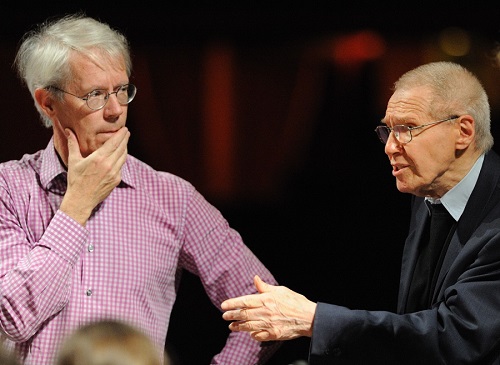
How did you get acquainted with Kurtág’s music? What were its characteristics that most affected you?
Some 25 years ago I scheduled Grabstein für Stephan with the Kammerorchester Basel and, due to a common friend, I could work with Kurtág for the first time, as he assisted to some rehearsals and one concert. We understood each other very well from the first moment on, and he liked my way of performing Haydn! His deep roots in classical music and his natural and unique way to combine this heritage with atonality, together with his most innovative technique of composing are the most fascinating sides of Kurtág’s music for me. Another point is the extreme expressivity and organicity of each phrase and each piece he composes: there is no single note that doesn’t speak or tell something in his whole oeuvre!
Cuendet and Kurtág at a rehearsal in 2010 (Photo: Laurent Thion)
You’ve arranged three compositions by Kurtág for ensemble up till now: in two cases your arrangements are expansions of the original (Zwiegespräch and Games), the third one is a reduction (…concertante…). Why did you choose these works?
I can’t say that I chose these works, rather they chose me! When I discovered for myself Kurtág’s unique method of constantly reworking his previous compositions and producing new works out of older pieces, especially out of his piano music Játékok (Games), I asked him if I could try to make my own instrumental versions of some of his piano pieces with different technics and improvisation. I tried it with my ensemBle baBel and we performed it also in Budapest. After this first, mostly improvised attempt, he encouraged me to fix some of them into a score: the result was very far from improvisation but it kept the idea of ‘games’ from his Games (Játékok). In the meantime, György Kurtág Jr asked me if I could try to arrange Zwiegespräch and later …concertante… . Both works represent great music but suffered from balance problems: in Zwiegespräch between the string quartet and synthesiser, in …concertante… between the two soloists and a very large symphony orchestra. The challenge was to give the right space to the music and also to reorganise the musical material (Zwiegespräch) or to simplify it (…concertante…).
In the case of Zwiegespräch, you did not only prepare an instrumentation but a completely new arrangement using percussion instead of a synthesizer; this version is planned to be premiered at Luzern Festival. How did you come to this new version?
György Kurtág Jr’s contribution to Zwiegespräch, the synthesizer part, is partly pre-recorded and partly played live and no score exists for it. So nobody else can perform it but he himself. Therefore, I suggested replacing the synthesiser by a solo percussionist who would create a new dialogue with the orchestra. The idea is not to imitate the sounds of the synthesiser by percussion, but to transpose the musical intentions, the structure and the poetic of the music of Kurtág Jr that dialogues with his father’s music into another world of sounds. As the music of the son is not always fixed and can change from one performance to another, I gave the percussion soloist a lot of space for improvisation with certain rules and within a fixed structure. Thus, Zwiegespräch, a dialogue between father and son, could be extended to a dialogue between a solo performer and a full orchestra and also between written and improvised music.
What were your models by finding the sonority of Kurtágian ensemble music?
This is a delicate question. My first reaction was, of course, to study Kurtág’s instrumental work – I had conducted most of his orchestral and ensemble pieces –, and they are indeed a treasury of instrumentation! But Kurtág himself asked me for being less respectful and not to imitate his instrumental language, so, he wanted me to be impertinent, finding other sonorities and “correcting” what he had written. I could mention Les Noces by Stravinsky, popular music with accordion, Varèse or Stockhausen as my inspirations. But I tried mostly to forget the original and to find the best way and colour for each phrase, chord, and section of these works.
How could you work together with Kurtág?
Our work together has always been based on mutual trust and understanding; I have learned so much from many discussions and rehearsals with him, not only about his works but about music in general! Sometimes I send him pages of my arrangement and he makes comments, or I call him to ask a question. But the best way has always been to work directly with him, discussing the scores and recordings of the performances; it isn’t always easy because it is sometimes difficult to separate the problem due to the interpretation, to the recording and of the orchestration. He has always been extremely demanding, but first of all towards himself, criticising his own composition; he can very well say something one day and the contrary the next day; the problem is that he is right both times and you have to take a decision!
Quotes and Intimacy - Péter Tornyai’s Premieres in December
 On December 1, works for a chamber ensemble by Balázs Futó and Péter Tornyai had their premieres at the Budapest Music Center, and on December 16, Asasello-Quartett will premier string quartets by Máté Balogh and Péter Tornyai in Neuss, Germany. All these works were commissioned by the Kunststiftung Nordrhein-Westfalen and the Péter Eötvös Contemporary Music Foundation. Péter Tornyai has been involved in both events, and he also talked about these new works, previous compositions and plans.
On December 1, works for a chamber ensemble by Balázs Futó and Péter Tornyai had their premieres at the Budapest Music Center, and on December 16, Asasello-Quartett will premier string quartets by Máté Balogh and Péter Tornyai in Neuss, Germany. All these works were commissioned by the Kunststiftung Nordrhein-Westfalen and the Péter Eötvös Contemporary Music Foundation. Péter Tornyai has been involved in both events, and he also talked about these new works, previous compositions and plans.
Both of your new works are somehow in dialogue with the history of music. The same is true of your Bach orchestration, the 5th Contrapunctus of The Art of Fugue, premiered in Leipzig this summer, which refers not only to Bach but also to Webern’s arrangement of Bach’s Ricercar. Is this kind of relationship to the past a temporary phenomenon or a permanent topic in your art?
(Photo: István Kurcsák)
This has always been of interest for me, and nowadays concert organizers also seem to like these connections. At Bach it was self-evident from the commission, and when I approached this music analytically, I found that I also have to deal with Webern’s arrangement. Interestingly, together with Máté Balogh and Balazs Horváth, I was invited to do some orchestral arrangements of other pieces of Bach’s cycle next year, and I can soon try other ways in them.
My composition for chamber ensemble, New Anamorphoses, also has a long history. I apply a technique known from visual arts, the creation of images that seem “meaningful” or “meaningless” from different perspectives to music, so that the “meaningful” perspective appears as a specific piece of music or musical style already known to the audience. The third movement of the new work, for example, is based on the first five chords of Haydn’s Kaiser quartet, which László Somfai has shown to be a kind of musical acrostic (Gott Erhalte Franz Den Caiser), but I could have used other classical harmony movements. When I built the first movement on Purcell’s Fantasia upon One Note, I distorted the musical perspective so that another part would become a single continuous sound. By the way, I sent an earlier version of this movement to my former teacher, Zoltán Jeney, and I learned from his reply that he was dealing with a similar “distuning” of Bach chorals back then. Among other things, this prompted me to dedicate the new work to him, and, after finishing it, to his memory.
Your new string quartet, Weitere intime Briefe, features only one past composer, Leoš Janáček, whose quartet Intimate Letters is one of your favourites as an active quartet violist. How does the connection work here?
However, there is no recognizable reference to past music, not even to Janáček’s works. In fact, I use only sketches from him that I have found in his notes written for his old-age lover, Camilla Stösslová, and which he has not used in his finished works. These details may come out of my own music environment here and there, but the listener really has nothing to recognize.
But more importantly to me, I was concerned with the intimacy of the sounds, like in many of my earlier pieces, for example, in the piano trio l'alone del silenzio, presented last year by students of Guildhall School, or in my recent piece Ferne that I wrote for Klangforum Wien. Harmonics, barely audible interplay of timbres display this intimacy, and I matched these special sounds with the Janáček story, some documents of which I recently came across.
Farewell to Zoltán Jeney
Zoltán Jeney, an outstanding personality in Hungarian composing, passed on October 27 at the age of 76.
 He studied composition with Ferenc Farkas at the Budapest Music Academy, then continued his studies with Goffredo Petrassin in Rome in 1967-68. In 1970, together with Péter Eötvös, Zoltán Kocsis, László Sáry, Albert Simon and László Vidovszky, he founded the New Music Studio in Budapest, an exceptional workshop of experimental music in Eastern Europe. He began to teach at the Budapest Music Academy in 1986, between 1995 and 2011 he was head of the Department of Composition, and from 1999 to 2013 he was the head of the Doctoral School, influencing several generations of young Hungarian composers.
He studied composition with Ferenc Farkas at the Budapest Music Academy, then continued his studies with Goffredo Petrassin in Rome in 1967-68. In 1970, together with Péter Eötvös, Zoltán Kocsis, László Sáry, Albert Simon and László Vidovszky, he founded the New Music Studio in Budapest, an exceptional workshop of experimental music in Eastern Europe. He began to teach at the Budapest Music Academy in 1986, between 1995 and 2011 he was head of the Department of Composition, and from 1999 to 2013 he was the head of the Doctoral School, influencing several generations of young Hungarian composers.
His works include all genres of music: His earned first international success with Soliloquium 1 for flute at the Gaudeamus Festival in Utrecht. Since the 1980s, his compositions have been regularly performed in Sweden, the Netherlands, North America and elsewhere. His main work is the three-hour oratorio Funeral Rite, which was completed in nearly twenty years, and was first performed in 2005 in full shape. His last great work, the cantata Aus tiefer Not, written on the 500th anniversary of the Reformation, received the Artisjus Prize in 2018.
He was one of the leading personalities of the experimental art movement that evolved in Hungary in the 1970s and 80s. In his early compositions, as elements of form, melody, rhythm and the tone system, he made frequent use of non-musical basic materials such as text quotations, chess game moves, solitaire game moves, telex text rhythms and other systems. From the 1980s onwards he began once again to apply counterpoint methods reminiscent of the Baroque and pre-Baroque periods, and in addition, there appeared in his music an archaic style of tone production that in its declamation and melody formation drew on both Gregorian traditions and those of Hungarian folk music. Although in technical terms, all his works pass on and sum up the basic principles developed in earlier decades of his activity, his works written in the last decades of his life have already overtly contained the emotional freedom and sensual immediacy that he deliberately concealed behind rigorous constructions.
In 1993 he was elected a member of the Széchenyi Academy of Literature and Art. From 1993 to 1999 he was a board member of the International Society of Contemporary Music and from 1996 to 1999 he was vice president. In recognition of his work as a composer, he was awarded the Erkel Prize in 1982, the Artist of Merit in 1990, the Kossuth Prize in 2001, the Bartók-Pásztory Prize in 1988 and 2006. In 1985, he was a research professor at Columbia University in New York. From June 1988, he spent one year with the DAAD Fellowship in West Berlin, and in 1999 he was a visiting professor at the Northwestern University Music Faculty in Chicago. Between 2000 and 2002, he collaborated with the City of London Composition DLA program.
He had close contact with UMP Editio Musica Budapest for over fifty years since the publication of his first work in 1968, but many common plans have not yet been realized and must be completed in his absence, in line with his spirit.
His oeuvre will be taken care and we will keep him in our memory
In memoriam Márta Kurtág (1927-2019)
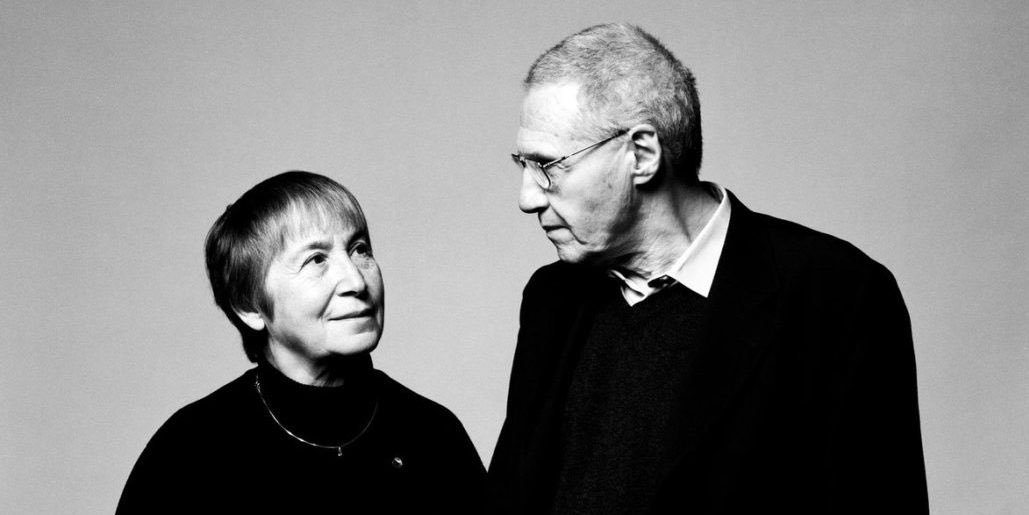 Pianist Márta Kurtág, György Kurtág's wife, his companion of inspiration and creation, passed away on October 17, 2019. She was 92, of which she spent 72 years on the side of her husband. She was the first critic of every composition in progress, the first consultant of every single musical idea, and a performing partner in Kurtág's piano works for solo and duet.
Pianist Márta Kurtág, György Kurtág's wife, his companion of inspiration and creation, passed away on October 17, 2019. She was 92, of which she spent 72 years on the side of her husband. She was the first critic of every composition in progress, the first consultant of every single musical idea, and a performing partner in Kurtág's piano works for solo and duet.
She was born on October 1, 1927, in Esztergom (Northern Hungary). She received her piano degree at the Liszt Ferenc Academy of Music in Budapest, studying with István Antal, Pál Kadosa and Lajos Hernádi. She taught at the Béla Bartók Secondary School of Music, then from 1972 until her retirement at the Franz Liszt College of Music Teacher Training. As a soloist and chamber musician, she was a regular actor in the Hungarian music scene from her youth, and has made several recordings. Since the 1990s, she was a major international musician, performing with her husband at Palais Garnier (Festival d'Automne a Paris), Cité de La Musique (Paris), Jerusalem Music Center, Library of Congress (Washington D.C.), New York's Carnegie Hall, on the stage of the Tonhalle in Zurich, she was a celebrated guest at the Aldeburgh Festival, the Salzburg Mozart Week or the Vienna Festive Weeks.
In February 2017, she and her husband received the Distinguished Achievement Award from the Borletti-Buitoni Trust in recognition of their outstanding musical work and lifelong musical co-operation. At the award ceremony, Mitsuko Uchida praised Kurtág's music and the piano play of the Kurtág couple: Kurtág is inspirational and fiercely honest but there is also a deep love that glows through his music. This may be an expression of his extraordinary relationship with his wife, Márta. Anybody who has heard the Kurtágs play, four hands, would know what that means. We know György Kurtág, the great composer, but with him always is Márta, the wonderful pianist. They live together in music. … We have all been so lucky to have known them and their music..."
We, working with Kurtág on publishing his works for decades, have been lucky enough to participate in this day for day. Márta was Kurtág's music partner not only beside the piano but also in his work on scores. Her advice and comments helped our work, as well. Without her, many years of publishing work on the opera Fin de partie would have been much more difficult. We owe her eternal gratitude for this.
We will miss her gentle smile, her caring love, her humour, helping even in difficult situations, but her always pertinent critical comments and advice will also be missing.
We'll keep her in our memory.
UMP Editio Musica Budapest
New CDs with Kurtág’s music
 Recently, three CDs with György Kurtág’s chamber works have been published. One features Heinz Holliger playing Kurtág’s and his own pieces for oboe, while the other two comprise Kurtág’s vocal music: one of them with the specialist Susan Narucki, the other with the debuting Viktoriia Vitrenko. The three recordings have already been widely reviewed; some of the reviews are quoted below.
Recently, three CDs with György Kurtág’s chamber works have been published. One features Heinz Holliger playing Kurtág’s and his own pieces for oboe, while the other two comprise Kurtág’s vocal music: one of them with the specialist Susan Narucki, the other with the debuting Viktoriia Vitrenko. The three recordings have already been widely reviewed; some of the reviews are quoted below.
Holliger was 80 last month, and ECM, which has recorded so many of his works, has marked the occasion with Zwiegespräche (Dialogues). It’s a collection mostly of miniatures, almost all including oboe, by Holliger and his kindred musical spirit, György Kurtág. Both Holliger and Kurtág studied with the Hungarian Sándor Veress, and have always shared a fondness for spare, aphoristic musical statements, so that these pieces form a stylistically coherent sequence. The pieces by Kurtág include movements for solo contrabass clarinet, and soprano and oboe, as well as the many pieces that he has composed for Holliger, including two that he wrote around the time of the death of Holliger’s harpist wife Ursula in 2014. In every piece the music is pared back to its barest essentials, so that a single pitch or interval acquires huge expressive importance. It all makes a marvellously austere birthday tribute, with Holliger at the centre of things as a performer too; it was recorded last year and his oboe playing has lost none of its authority and peerless musicianship.
(Andrew Clements, The Guardian)
This disc celebrates the 80th birthday of Heinz Holliger, and although it explores his interpretative gifts as a performer rather than his full range as a composer, its focus on the dialogues between his own music and that of György Kurtág makes for a beautifully rounded double portrait. That this is an intensely intimate retrospective is clear from the very first item: Kurtág’s gentle, heartfelt tribute to Holliger’s harpist wife Ursula, who died in 2014. Its poignancy is all the greater since it sounds almost like an impersonation of one of Elliott Carter’s late instrumental miniatures – and Carter, who wrote so memorably for both the Holligers, had himself died just a few months before. But Kurtág, like Holliger, owes even more to the astringent yet profoundly lyrical expressiveness of Webern, and this quality often surfaces, sometimes with touches of un-Webernian irony, in works like Kurtág’s Hommage à Elliott Carter and … (Hommage à Tristan), which condenses Wagner’s sublime five-hour portrayal of death and transfiguration into a mere 40 seconds for oboe and bass clarinet. As you might imagine, every note counts!
(Arnold Whittall, Gramophone)
The lonely shepherd on the beach, waiting for the beloved, blowing on the double-reed, calling, plaintive: bucolic associations of this kind go through your mind, from the first note, a letter from afar, the György Kurtág in memory of the 2014 deceased Harpist Ursula Holliger wrote. Her husband, Heinz Holliger, intones this piece on the oboe heartbreakingly elegiac. No coincidence, if we encounter a similar mood several times among the 37 tracks of this CD. Often it is about memories of the deceased, tributes to friends, reminiscences of music history, very touching, calling, conjuring, mournful, sometimes indelicate, sometimes in dark colors. Dialogue is the name of the CD that the label ECM dedicates to Holliger for his 80th. On the cover appear both, Holliger and Kurtag’s name. It is the testimony of a long artistic friendship. This very coherent CD tells about it. And if one thinks the whole thing sounds very homogeneous, one discovers nuances, mysterious ones. So sometimes the pieces go back and forth between the two.
(Thomas Mayer, Schweizer Musikzeitung)
Holliger and Kurtág, Kurtág and Holliger: despite all the differences in their career and their work, there are many kinships. Both had Sándor Veress as master, one in Hungary, the other in Switzerland. Two substantial works by Holliger cope with a multitude of short works by the two composers. Those of György Kurtág come for many Signs, games, and messages, an extension for other instruments of the most famous Games (Játékok) for piano, including some recent and unpublished works to the disc. Kurtág and Holliger are not alone on this record: it is a living history of the music that is there with them, the English horn of the third act of Tristan, the introductory solo of the Rite of Spring, and much more. Holliger’s and Kurtág’s works are inhabited by pain and loss; this record bears witness to this, but it also strikes by its fullness of sound and expressive richness.
(Dominique Adrian, www.resmusica.com)
 The soprano Susan Narucki has been an unflinching champion of a huge range of contemporary music, but the vocal works of György Kurtág have always had a central place in her repertoire. Her collection is based around two of Kurtág’s greatest vocal works, Scenes from a Novel, on texts by the Russian poet Rimma Dalos, and the Attila József Fragments. It’s music that demands the most scrupulous attention to detail. “Every piece of information on the page is essential” says Narucki, and her performances convey that sense of having overlooked nothing, while always preserving the expressive freedom and intensity that are such a vital part of Kurtág’s writing. As well as the major Dalos and József cycles, Narucki also sings the much more compact group of Dalos settings, Requiem for the Beloved, which along with the Three Old Inscriptions, have just piano accompaniment, and are the nearest things here to conventional songs. The four numbers in Requiem last barely five minutes, yet they map an emotional journey just as vividly as many cycles 10 times as long. Narucki’s wonderfully subtle shading and control registers each twist and turn in the journeys of every one of these songs. The whole disc provides total immersion in Kurtág’s utterly distinctive world, one in which nothing is taken for granted and even the smallest detail is conferred with profound, totally compelling meaning.
The soprano Susan Narucki has been an unflinching champion of a huge range of contemporary music, but the vocal works of György Kurtág have always had a central place in her repertoire. Her collection is based around two of Kurtág’s greatest vocal works, Scenes from a Novel, on texts by the Russian poet Rimma Dalos, and the Attila József Fragments. It’s music that demands the most scrupulous attention to detail. “Every piece of information on the page is essential” says Narucki, and her performances convey that sense of having overlooked nothing, while always preserving the expressive freedom and intensity that are such a vital part of Kurtág’s writing. As well as the major Dalos and József cycles, Narucki also sings the much more compact group of Dalos settings, Requiem for the Beloved, which along with the Three Old Inscriptions, have just piano accompaniment, and are the nearest things here to conventional songs. The four numbers in Requiem last barely five minutes, yet they map an emotional journey just as vividly as many cycles 10 times as long. Narucki’s wonderfully subtle shading and control registers each twist and turn in the journeys of every one of these songs. The whole disc provides total immersion in Kurtág’s utterly distinctive world, one in which nothing is taken for granted and even the smallest detail is conferred with profound, totally compelling meaning.
A performance of Scenes from a Novel, with Viktoriia Vitrenko as the soprano, is also the first work on Scenes, a Kurtág collection from Audite. The Seven Songs and In Memory of a Winter Evening are also common to both discs, but Vitrenko’s contributions also include the first-ever recording of Several Movements from Georg Christoph Lichtenberg’s Scrapbooks, settings of aphorisms by the 18th-century satirist, in which the soprano is supported by just a solo double bass. Vitrenko is a cooler, less expressively generous interpreter than Narucki, but her disc is invaluable nevertheless; it fills in another small gap in our knowledge of one of the greatest composers of our time.
(Andrew Clements, The Guardian)
 In recent decades, Kurtág's oeuvre has slowly but surely been discographically disclosed, but apparently a few things remain to be discovered, witness these two new editions with cyclical works for soprano and instruments. Of course, we also find pieces that have already been recorded several times, and both CDs overlap in the Scenes from a Novel, Seven Songs, and Memory of a Winter Sunset. The American soprano Susan Narucki tells how she studied these works together with Kurtág. Obviously, you can hear that she has now passed sixty, but that does not detract from the intensity of her interpretation and the meticulous care for the detail that Kurtág drilled into it in long sessions. The twenty Attila József Fragments for soprano solo provide a wonderful example. Viktoriia Vitrenko is at the start of her career. The "selling point” of this CD is the first recording of the Einige Sätze aus den Sudelbüchern Georg Christoph Lichtenbergs, a cycle of ironic aphorisms of the German poet Lichtenberg (1742-1799). Vitrenko has taken a golden hold for her partner on the double bass: none other than Niek de Groot, former solo bassist of the Concertgebouw Orchestra, takes care of this caninely difficult party, and how! The CD is more than worth the effort for this work alone, but that is just the beginning. Vitrenko not only has a beautiful voice, a formidable technique, she is also a gifted singing actress.
In recent decades, Kurtág's oeuvre has slowly but surely been discographically disclosed, but apparently a few things remain to be discovered, witness these two new editions with cyclical works for soprano and instruments. Of course, we also find pieces that have already been recorded several times, and both CDs overlap in the Scenes from a Novel, Seven Songs, and Memory of a Winter Sunset. The American soprano Susan Narucki tells how she studied these works together with Kurtág. Obviously, you can hear that she has now passed sixty, but that does not detract from the intensity of her interpretation and the meticulous care for the detail that Kurtág drilled into it in long sessions. The twenty Attila József Fragments for soprano solo provide a wonderful example. Viktoriia Vitrenko is at the start of her career. The "selling point” of this CD is the first recording of the Einige Sätze aus den Sudelbüchern Georg Christoph Lichtenbergs, a cycle of ironic aphorisms of the German poet Lichtenberg (1742-1799). Vitrenko has taken a golden hold for her partner on the double bass: none other than Niek de Groot, former solo bassist of the Concertgebouw Orchestra, takes care of this caninely difficult party, and how! The CD is more than worth the effort for this work alone, but that is just the beginning. Vitrenko not only has a beautiful voice, a formidable technique, she is also a gifted singing actress.
(Siebe Riedstra, www.opusklasiek.nl)
In addition to new interpretations of already well-documented works, 22 settings of Lichtenberg suddle books will be presented for the first time on this CD. Kurtag is the composer who wrestles for every note, which has an ethical aspect for him; he wants to be responsible for his notes. Another important feature is the closeness to the human voice, which is also expressed in most of the works here. And last but not least, the opening scenes of a novel are characterized by the use of genuinely Hungarian instruments, soprano, violin, cimbalom and double bass. The Ukrainian soprano Viktoriia Vitrenko masters the entire breadth of expressive variability necessary for these works, from the muted to the eruptive tone.
(Uwe Krusch, www.pizzicato.lu)
Before the premiere of Alabama March: A talk with Máté Balogh
 Máté Balogh's Alabama March was commissioned by the Huntsville Symphony Orchestra of Alabama. The premiere will take place on September 27, 2019, in Huntsville. We asked the composer about composing for orchestra, his relationship with tradition, and the meeting of different cultures.
Máté Balogh's Alabama March was commissioned by the Huntsville Symphony Orchestra of Alabama. The premiere will take place on September 27, 2019, in Huntsville. We asked the composer about composing for orchestra, his relationship with tradition, and the meeting of different cultures.
You have said recently: Alabama March is your first genuine orchestral piece. Obviously, there were precedents in your career: what is different about Alabama March?
For obtaining my composing diploma, I wrote a series of orchestral variations on a Haydn theme - better to forget today. Then the competitions of the New Hungarian Composers' Forum gave me the opportunity to write orchestral pieces. In 2015, I won an award for my piece Quintet, but it was actually made up of five chamber ensembles together, it wasn't a real orchestral composition. It can be said that my composing routine did not primarily concern orchestral apparatus.
How did it come to this commission?
Last December, Gergely Vajda, the chief conductor of the Huntsville Symphony Orchestra, asked me to compose a short piece to mark the 200th anniversary of the founding of State of Alabama. It immediately occurred to me that I was going to write a symphonic march. I liked the idea so much that I completed it in two days. In hindsight, it occurred to me that maybe Weill's Alabama Song from Mahagonny might influence me. At the Franz Liszt Music Academy, I was teaching the history of Sprechgesang, so I did a lot of work with Weill at the time.
March is an existing musical movement and it helped a lot; it has a traditional instrumentation structure that provided security. I used the soloistic melody types used in the genre, partly the usual accompaniment figures. In an earlier piece of mine, Pseudomarsch, I used similar motifs. Although that work was only for brass band, I was not thinking of chamber music, but rather of bulky sound. With Pseudomarsch I won first prize at a composer competition in 2017; since then it has been recorded by the Hungarian Radio, has been broadcast several times, and in the meantime, I have received commissions from brass bands to compose marches – thus, to put it overstated, composing marches has become almost my trademark.
Of course, that's not just where your skills in marches come from ...
Yes, my father led the Dunaújváros Brass Band and I was playing different instruments since I was 7 years old. The repertoire consisted mostly of military music, much of the Austro-Hungarian tradition, but of course, we also played a lot of American brass music: I can play Sousa’s Washington Post March even today by heart.
And how do you relate to this repertoire? Can you take it seriously? Or are you more sarcastic?
When composers use the march on the concert stage, separated from real or operatic movements, one must always suspect the joke. In Mozart’s Non più andrai it is obvious that it must be perceived as a gag, Schubert's four-handed marches are only humorous, and Mahler’s marches often give similar impressions, mostly as a mixture of tragic and comic elements. At an American football game, when they march in with cheerleaders and giant sousaphones, I can't take it seriously either.
I wrote my own march with such back hints: This is a serious joke. Whenever I build my own music on something from the past, I always need to stay away from it. There is always some irony in this, perhaps sarcasm. I do not know how this will be perceived in America, but being Eastern European, it is self-evident for me.
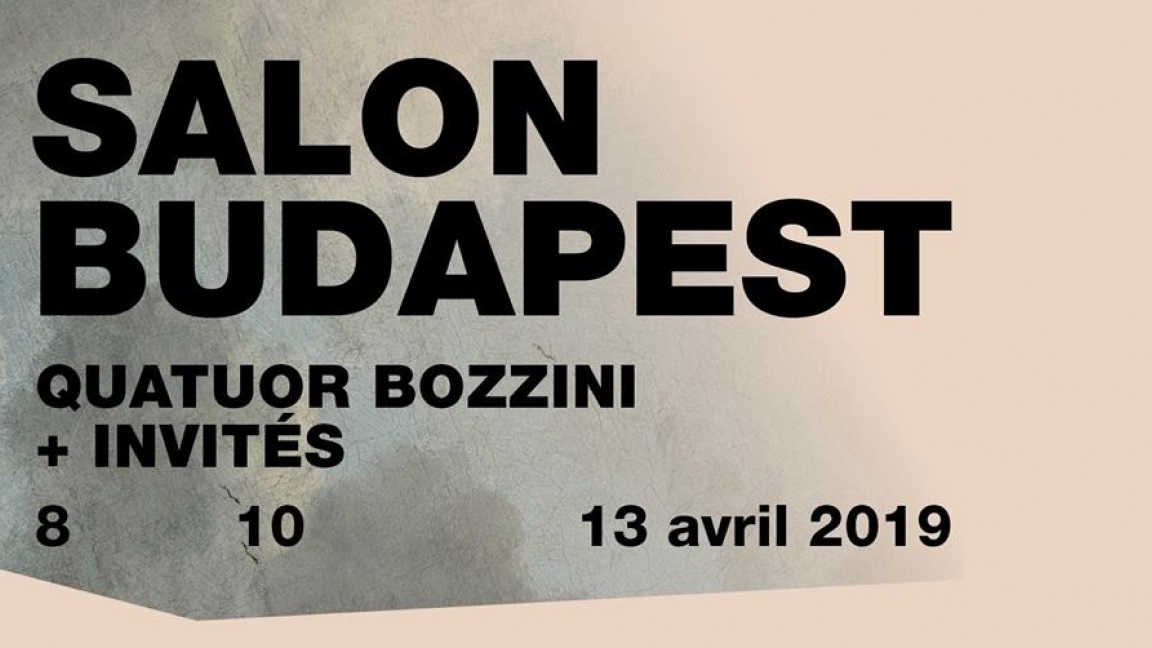 The Canadian Bozzini String Quartet presented Hungarian chamber music to the Montréal audience at three concerts in early April. Most of the works have been presented as first performances in Canada. Besides one work of older masters, György Ligeti and György Kurtág (… pas à pas – nulle part…), respectively, László Vidovszky (12 String Quartets) and Gyula Csapó each had a string quartet, and the last night’s program included three works by Zoltán Jeney.
The Canadian Bozzini String Quartet presented Hungarian chamber music to the Montréal audience at three concerts in early April. Most of the works have been presented as first performances in Canada. Besides one work of older masters, György Ligeti and György Kurtág (… pas à pas – nulle part…), respectively, László Vidovszky (12 String Quartets) and Gyula Csapó each had a string quartet, and the last night’s program included three works by Zoltán Jeney.
Clemens Merkel, the first violinist of the string quartet, commented on the festival for Le Canal auditif: “We play these composers regularly outside of Montreal, especially works by Jeney and Csapó. They were all connected to the New Music Studio in Budapest, founded in 1970 by Péter Eötvös, Zoltán Jeney, Zoltán Kocsis, László Sáry and László Vidovszky. We performed, for example, Jeney’s compositions often at a Swedish festival in Borås. Now we present chamber music that hasn't yet been heard in Canada, but we think it’s worth getting to know them.”
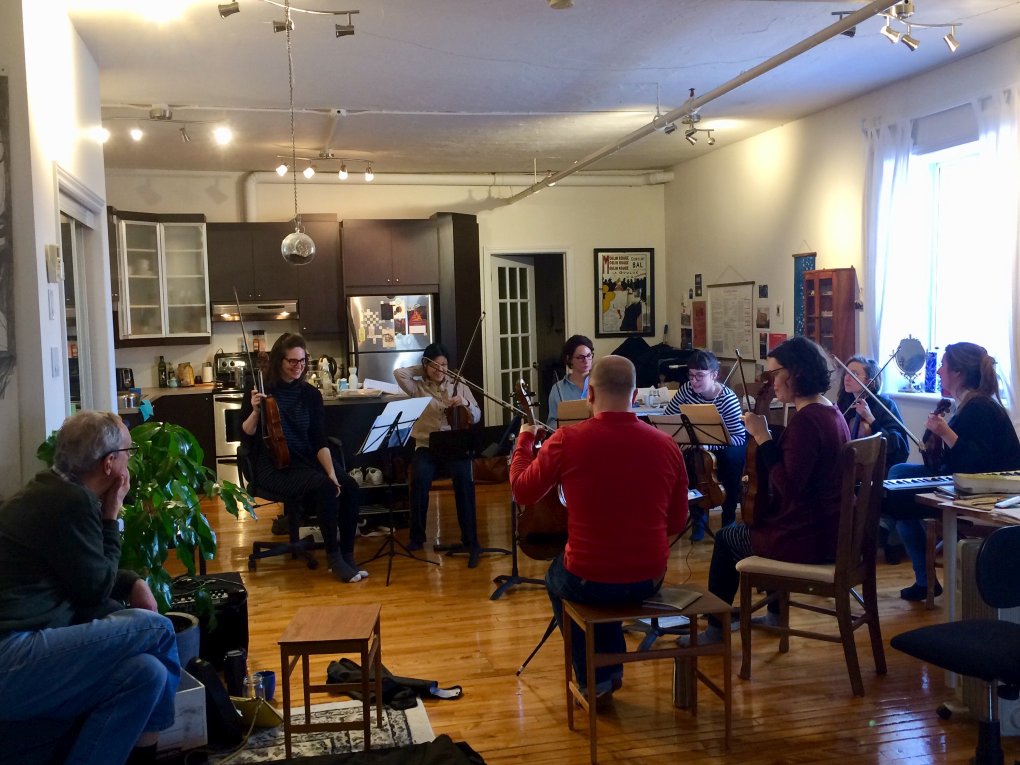
The last concert is also special in that 22 students of the Saint-Laurent school join the string quartet in the performance of Zoltán Jeney's something like and something round. These two works are like being negatives of each other, both in intensity and in musical movement. “This is static music, says Merkel, the pieces have no story, they are like video installations where apparently nothing moves, but they are full of tiny shades. As 25 violins play at the same time, something always happens.”
Rehearsal of Jeney's composition (Photo: Quatuor Bozzini)
György Kurtág's Opera in Amsterdam
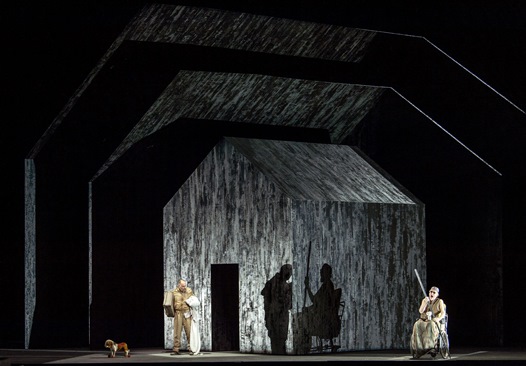
Leigh Melrose (Clov) and Frode Olsen (Hamm) (Photo: Ruth Walz)
Four months after its premiere in La Scala, on March 6, Kurtág’ Fin de partie was revisited in the Dutch National Opera. The cast was identical with that of the world premiere: Frode Olsen (Hamm), Leigh Melrose (Clov), Hilary Summers (Nell) and Leonardo Cortellazzi (Nagg); the Nederlands Radio Philharmonic Orchestra was conducted by Markus Stenz, the performance was directed by Pierre Audi.
Selection from the press echo:
The pieces by Samuel Beckett have often been linked to jet-black expressionism, to hell and damnation at Bosch. The opera version of Fin de partie keeps it abstract. At most, a hint of mild ridicule can be detected. The chopped figures that populate Beckett's desolate world: this time they are also missing their brutal features. György Kurtág lovingly embraces them with his musical conversion. His endgame sounds humane, almost tender.
Kurtág must have felt strongly about the rhythm of Beckett's monologues: the sung text is on the skin. In their most lyrical moments they also cherish the four expired creatures. The orchestra becomes a precision instrument at Kurtág, which sets well-aimed accents and exclamation marks. A crumbling melody, set on accordion, is stopped by rustling percussion. Kurtág blows fragile soap bubbles between massive nut clusters. The final is rolling in strong waves. It seems to fade out like a lullaby, but then springs up again. Between resignation and wonder about human fate: this is how this moving music theater ends. It leaves you perplexed.
(Gert van der Speeten, De Standaard)
A more perfect marriage of text and music could hardly be imagined. Almost as perfect as the love of Nell and Nagg, who live out their lives in adjacent garbage cans – or indeed of Kurtág and his wife Márta, who for seven decades has been his indispensable helpmate in composition and performance. Kurtág’s Fin de Partie is a last, loving farewell to the era of 20th-century high modernism, now long since succeeded by different idioms and ideas of what classical composition might be. Yet Kurtág’s idiom hardly feels dated. Like Messiaen’s St. François d’Assise, Kurtág sums up all his own musical past but also the tributaries that flowed into his own utterly individual style: the eloquent recitatives of Monteverdi and Debussy, the lapidary concision of Webern, the vivid coloration of Messiaen himself. Kurtág’s music has long been concise; in that respect he most overtly resembles Webern. Yet as the opera goes on, the music seems to expand, wrapping the characters and their lines in warm, elegiac sadness. By the end – maybe throughout – it is very, very beautiful.
(John Rockwell, Classical Voice North America)
 Kurtág stands as the master of the musical miniature. Every note has been reduced to the bare essence. With almost nothing, Kurtág manages to make the inner states of mind and emotional conflicts of the main characters audible. His music has a merciless directness and despite the minimalist approach, Kurtág has an enormous range of sound colors. His Fin de partie is a true musical masterpiece. It is a well-balanced mixture of thin harmonies, (sometimes) slavic rhythms, rustling, scratching, knocking and blood-curdling eruptions of the brass instruments. It is an extremely theatrical score in which everything, in the finest details, falls into place. A score that was performed by Markus Stenz and the Radio Philharmonic Orchestra with admirable flexibility and accuracy.
Kurtág stands as the master of the musical miniature. Every note has been reduced to the bare essence. With almost nothing, Kurtág manages to make the inner states of mind and emotional conflicts of the main characters audible. His music has a merciless directness and despite the minimalist approach, Kurtág has an enormous range of sound colors. His Fin de partie is a true musical masterpiece. It is a well-balanced mixture of thin harmonies, (sometimes) slavic rhythms, rustling, scratching, knocking and blood-curdling eruptions of the brass instruments. It is an extremely theatrical score in which everything, in the finest details, falls into place. A score that was performed by Markus Stenz and the Radio Philharmonic Orchestra with admirable flexibility and accuracy.
(Oswin Schneeweisz, De Theaterkrant)
Hilary Summers (Nell) and Leonardo Cortellazzi (Nagg) (Foto: Ruth Walz)
Four figures locked in themselves, unable to make contact, circling around each other. They are waiting for their end, an end that will not come. For me this is an opera that deals with the will to achieve, the ambition, the tendency of people to always want to move forward. All that is, Kurtág and Beckett say, an illusion. That is what Kurtág must have appealed to and that is what he is shaping here musically. And he does that first and foremost with a great deal of respect for Beckett's text and language. The scenes that he copied sound integral and Kurtág fully adapts to the rhythm of Beckett's language with his music.
What happens here at the National Opera borders on the unspeakable. Kurtág and Beckett and then this result in the direction of Pierre Audi, with the music phenomenally played by the Radio Philharmonic Orchestra, conducted by Markus Stenz and with four soloists who bring this incredibly complex piece to a superior end. Frode Olsen puts Hamm in exactly the right mix between malice and helplessness, Leigh Melrose is brilliant as the excited, helpless, but just as aggressive Clov, Leonardo Cortellazzi is excellent cast as the somewhat naive Nagg and finally we hear Hilary Summers as a dreamy Nell.
(Ben Taffijn, Niuwe Noten)
Announcing the release of Péter Wolf's Wolf-temperiertes Klavier
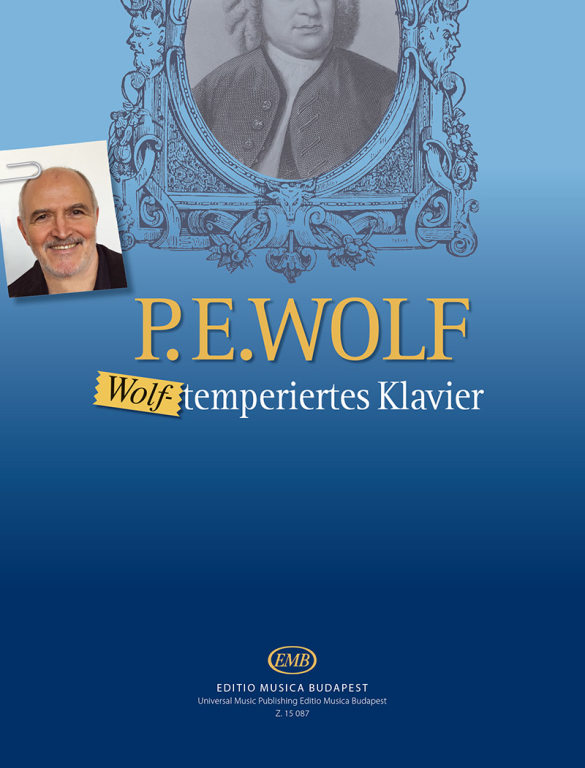 The model for the Wolf-temperiertes Klavier, as the title might suggest, is Johann Sebastian Bach’s keyboard cycle Das Wohltemperirte Clavier. In line with this, Péter Wolf’s collection of 24 piano pieces uses each of the twelve notes of the octave from C to B as home keys (both major and minor) for the movements. It differs from the Bach work in having no fugues, only freely composed praeludia, or as Chopin would have called them, preludes. Péter Wolf is more strongly linked to Chopin and the Romantic and twentieth-century prelude tradition he engendered than directly to Bach, insofar as etude-like virtuoso movements are interspersed with meditative, sentimental pieces in a series that takes us through the world of 24 keys, and the piano technique required is closer to the age of Romanticism than to the Baroque.
The model for the Wolf-temperiertes Klavier, as the title might suggest, is Johann Sebastian Bach’s keyboard cycle Das Wohltemperirte Clavier. In line with this, Péter Wolf’s collection of 24 piano pieces uses each of the twelve notes of the octave from C to B as home keys (both major and minor) for the movements. It differs from the Bach work in having no fugues, only freely composed praeludia, or as Chopin would have called them, preludes. Péter Wolf is more strongly linked to Chopin and the Romantic and twentieth-century prelude tradition he engendered than directly to Bach, insofar as etude-like virtuoso movements are interspersed with meditative, sentimental pieces in a series that takes us through the world of 24 keys, and the piano technique required is closer to the age of Romanticism than to the Baroque.
Listen to: Adagio in E by Péter Wolf, played by József Balog (excerpt)
The score can be ordered here.
Péter Wolf writes what he hears and feels, and this fundamental attitude determines all of his pieces, regardless of what genre he happens to be composing in. And his oeuvre is highly varied. He set out as a pianist, and was admitted to the choral conducting programme at the Budapest Liszt Academy, but instead he studied jazz piano, meanwhile he drifted along with the current of music life, mainly popular music: he played in bands, supplied backing vocals, saved sound recordings, and was an understudy pianist. He composed hit songs, hit film music, made countless arrangements (through the Franz Liszt Chamber Orchestra he came across Isaac Stern, for whom he made arrangements of an entire CD’s worth released on the Sony label in 1998) and wrote much “classical” music too: piano pieces, orchestral works, concertos, and so forth. In 2017 he was awarded the Artisjus Prize for Artist’s Lifework in Popular Music.
His music makes intensive use of almost everything that can be used in a given context, be it from the classical tradition, jazz, or pop music. In this regard we might consider him postmodern, yet there’s something that distinguishes him from the post-war postmoderns. The latter indulged in unbridled cannibalization of anything from the musical past (and their contemporary present), but always did so with ambiguous, guileful irony: the quotation was never in doubt, but its meaning and aesthetic judgement was. Péter Wolf’s post-postmodern music never uses “quotation marks”; this music takes itself seriously in the most classical sense of the word. If he gives a nod to Debussy or Chopin in the 24 piano pieces (just to mention two composers whose figures loom large at several levels), he happily immerses himself in the given musical world, and behind his playing with styles one always senses a deep reverence for the composer referred to. And the movements inspired by popular music, brimming over with emotion, are also free from irony. Péter Wolf firmly believes that music is to be heard, and expresses feelings, and as he is a sincere artist not prepared to comply with external expectations, he follows only his own nose (or ears, or heart); his music too, with untrammelled homeliness, wallows in the musical styles of past centuries and current times.
Péter Wolf’s deft hand not only guides us steadily through a kaleidoscopic cascade of styles, but also vouches for the extraordinarily colourful pianism, and at times dazzling virtuosity, which is at least as important a feature of the Wolf-temperiertes Klavier as the musical ideas themselves. The piano textures of Chopin and Debussy, along with Gershwin’s pianistic ideas, must have been key impulses when the pieces were written, but the true source of inspiration was in all likelihood József Balog, who first played and recorded the works. (Gergely Fazekas)
Kurtág's opera Fin de partie premiered in Teatro alla Scala

Leonardo Cortellazzi (Nagg), Leigh Melrose (Clov) and Frode Olsen (Hamm). Photo: Ruth Walz
On November 15, Teatro alla Scala premiered György Kurtág’s opera Samuel Beckett: Fin de partie, scènes et monologues. In the long-awaited opera Kurtág set Beckett’s drama, which he had seen as a theater performance in 1957 in Paris. The textbook was compiled by the composer, using about half of the playwright’s play, strictly following the process of the drama.
The cast of the world premiere included Frode Olsen (Hamm), Leigh Melrose (Clov), Hilary Summers (Nell) and Leonardo Cortellazzi (Nagg); the orchestra of La Scala was conducted by Markus Stenz, the performance was directed by Pierre Audi.
The performance was created as a joint production with the Dutch National Opera, and further performances will be shown in Amsterdam on March 6, 8, and 10, 2019.
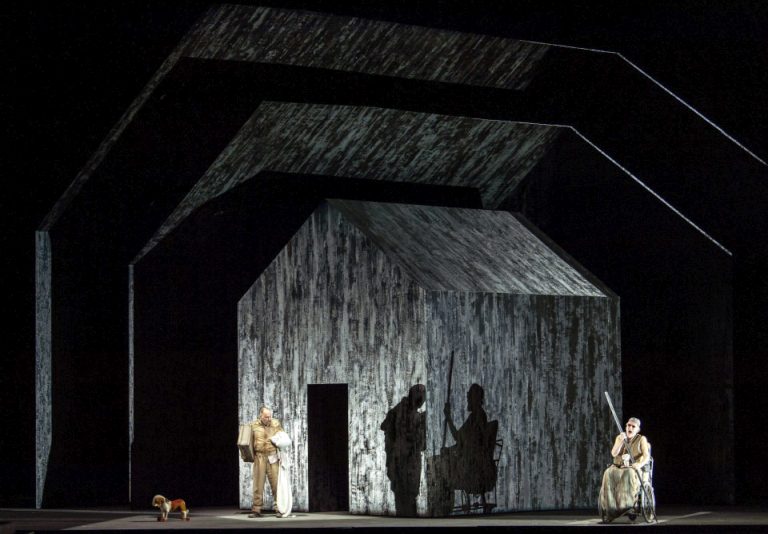
Leigh Melrose (Clov) and Frode Olsen (Hamm). Photo: Ruth Walz
Selection from international press echoes:
Fin de partie is a farewell not just to a life and a marriage, but also to a whole culture. Mr. Kurtág is one of the last who remain of the generation of avant-garde composers that came of age during World War II and in its wake: Boulez, Ligeti, Henze, Stockhausen, Schnittke. Even if the great final scene equivocates — modernism is always on the verge of leaving, it seems to say, yet it is also always here to stay — the opera, drawn from a play that Mr. Kurtág saw in Paris as a young man, is truly goodbye to all that.
(Zachary Wolfe in The New York Times)
The result is a personal tribute to a lifetime’s work. Scrupulous attention to detail, typically exhibited in Kurtág’s miniature compositions, is unflaggingly applied over the opera’s two hours. Myriad orchestral shards colour the French text, which here takes primacy over all. The vocal parts are brilliantly sculpted — refined by Kurtág and the singers over years — and resemble recitation with instrumental support.
(James Imam in Financial Times)
Um Äußerlichkeiten freilich hat Kurtág sich nie geschert, eher lässt einen die Kluft zwischen Plüsch und Partitur doppelt hellhörig werden, und das mag er sich zu Hause in Budapest sogar gewünscht haben (zur Scala-Premiere konnten die Kurtágs nicht kommen). Die "Gefühlswegweiser" seiner Partitur zielen in viele Richtungen: tief ins eigene Œuvre hinein, aber auch zurück zu Monteverdi, zu Debussy und Alban Berg oder gar ins vaudevillehaft Folkloristische (mit Zimbal, Akkordeon und anderen Instrumenten). Eine pergamenten leichte, nie eklektizistische Hand pflegt Kurtág im Umgang mit diesen Farb- und Gedächtnisvaleurs, und so tritt man nach zwei pausenlosen Stunden erfrischt hinaus in die Nacht, ja fast ein bisschen aufgestachelt.
(Christine Lemke-Matwey in Die Zeit)
Kurtágs konzise Musik erweitert Becketts Text in zweifacher Weise: Zum einen bringt sie die Sprache wahrhaft zum Klingen, und zwar in durchweg traditioneller, bisweilen ins Ariose ausgreifender Singweise, dabei aussergewöhnlich subtil dem Sprachfall des französischen Originaltextes nachlauschend. Zum anderen erfasst die Musik aber auch das szenische Geschehen, also die in regelrechte Pantomimen ausufernden Regievorgaben Becketts, die das gross besetzte Orchester in geradezu filmisch-illustrative Klanggesten übersetzt, ohne sie ins Comichafte zu überzeichnen.
(Christian Wildhagen in Neue Zürcher Zeitung)
Kurtág ist ein nüchterner Aphoristiker. Er nimmt zwei Stückchen der alltäglichen Misere und schlägt sie wie Feuersteine aneinander, daraufhin leuchtet ganz kurz ein nie gesehener geheimnisvoller Funke auf, der gleich wieder verlöscht. In „Fin de partie“ reihen sich Hunderte solcher Funken aneinander. Sie sind Kurtágs Kommentare zu Stückverlauf und Charakteren. Sie verleugnen nie ihre Verwandtschaft untereinander, aber Kurtágs Fantasie ist derart unerschöpflich, dass keine Wiederholungen entstehen.
(Reinhard J. Brembeck in Süddeutsche Zeitung)
Kurtág fa Kurtág, non mette nulla di nuovo sul pentagramma, non aggiunge nulla alla sua estetica, non apre squarci interpretativi rivoluzionari rispetto a una carriera fedele a se stessa, alla poetica del frammento, alla rilettura – anche ironica – della forme musicali classiche. Kurtág fa Kurtág. Ma lo fa all’ennesima potenza . E realizza un capolavoro inteso come punto di arrivo, come vertice dove il credo musicale di una vita trova l’espressione più compiuta.
(Pierachille Dolfini in Avvenire)
Kurtág non compone una partitura a commento del soggetto, bensì contrappunta il testo parola per parola, tanto che il messaggio più “puro” lo si coglie solamente nell’Epilogue, con cinquanta battute di sola musica (molti gli accordi misteriosi in pppp) che riassumono il mood di tutta l’opera.
(Luca Chierici in Il Corriere musicale)
Works for clarinet by Gergely Vajda on a new CD
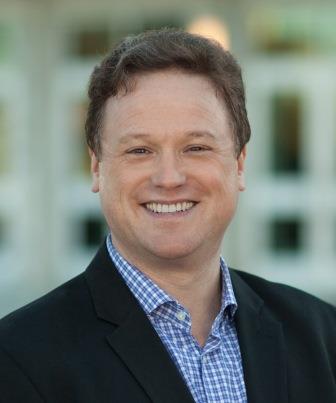 Three compositions by Gergely Vajda, Clarinet Symphony for two clarinets and orchestra, Alice Études for clarinet and string quartet, and Persistent Dreams for solo clarinet, have been recorded on a new CD, released by the Budapest Music Center Records. This offered the occasion to ask Gergely Vajda about his versatility.
Three compositions by Gergely Vajda, Clarinet Symphony for two clarinets and orchestra, Alice Études for clarinet and string quartet, and Persistent Dreams for solo clarinet, have been recorded on a new CD, released by the Budapest Music Center Records. This offered the occasion to ask Gergely Vajda about his versatility.
Clarinettist, composer, conductor – you have all these in your biography. Which is your priority order of these three “c”-s?
I don’t want to offend conductors or instrumentalists but I think creating something from nothing is probably the “king” of all activities, that’s how you can get closest to “Creation” as a human being. If you have the calling for being a composer that should be number one in your life. Performers have to work with the material they get from the composer. I quite often conduct my own works, and then I’m trying to translate my own music into practical terms, to bring it to life.
On your new CD, labelled as Clarinet Symphony, you have works written for clarinet or clarinets and other instruments. Do you feel more at home if you write for your own instrument compared to writing for other instruments?
There is always a point when I remember the physical connections. I don’t compose with my clarinet in hand. Back in the days, twenty-five years ago, when I wrote my very first solo piece, Lightshadow-trembling, I did just that. But these newer pieces were written without, just working in front of the computer screen. The memory of the physical contact, the vibration of the sound, is, however, definitely there, more in case of the clarinet than with other instruments.
Alice Études is a paradoxical piece: On one hand, you find a quotation from Lewis Carroll’s book in every movement, so one would expect it to be program music. On the other hand, it is a series of études for a quintet with clarinet. How would you define the relationship of these two terms?
Études are my meditations based on how I’m reading Alice. The short texts that go with each étude work as inspiration; they all trigger something musical. And that’s how études come in: something is moving, and then you do something with that material. These are études not in the technical sense but on different sounds of the ensemble of a clarinet and a string quartet. As a clarinetist I’ve played a huge classical repertoire and a lot of modern music, so I can say: Schumann didn’t necessarily care about the difference between oboe and clarinet, thus his Fanatasiestücke can be played on both instruments or even on viola. But other composers, like Mozart or Brahms, did really get into the soul of the clarinet. Mozart had an immediate sound in his head, as you can see it also in his operas where clarinet or basset horn goes with certain types and characters. And that’s what I was trying to get in Alice Études: The clarinet is somehow “Alice-y” for me, so I could experiment with the clarinet being Alice in this setup. And because the clarinet can blend with different string combinations and yet there is always a contrast between clarinet and strings, the most interesting for me was how I can mix this sounds in each etude in a different way, at the same time keeping a unity of the composition.
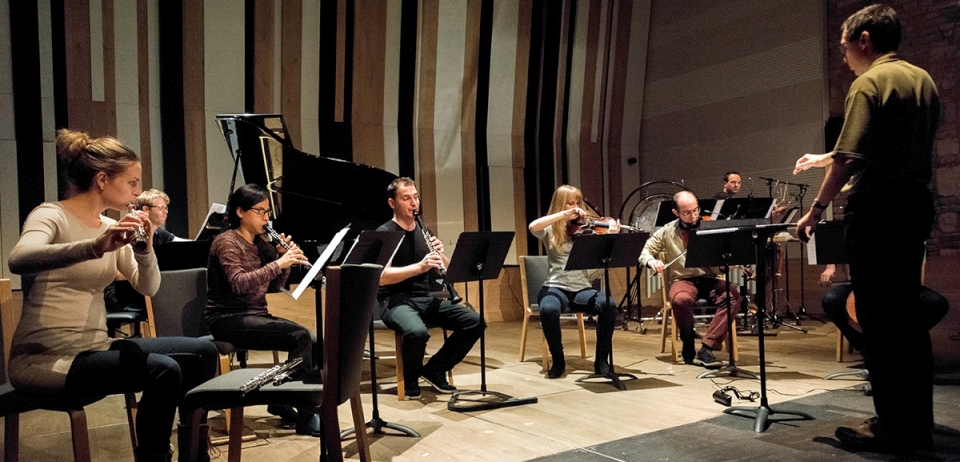
THReNSeMBle with Balázs Horváth (Photo: Andrea Felvégi)
The beginning of Máté Balogh’s, Máté Bella’s, Péter Tornyai’s and Balázs Horváth’s musical career is in many ways tied to Péter Eötvös, who was their driving force in the past few years. It is therefore no surprise that the majority of the programme of the Peter Eötvös Contemporary Music Foundation’s (which Eötvös founded in 2004) concert in Zurich on 26 June consists of works composed between 2010 and 2016 by these young composers. Jam Quartet by Máté Balogh, Chuang Tzu’s Dream by Máté Bella, QuatreQuatuors by Péter Tornyai will be performed for the first time in Switzerland, pikokosmos = millikosmos by Balázs Horváth will be premiered in Zurich. The audience in the Tonhalle will hear the music of three generations. Apart from the Swiss premiere of Eötvös’s da capo (Mit Fragmenten aus W. A. Mozart’s Fragmenten), Kurtág’s Brefs Messages will also be performed. The program is conducted by Eötvös himself, performed by the THReNSeMBle, the ensemble of the Contemporary Music Foundation.
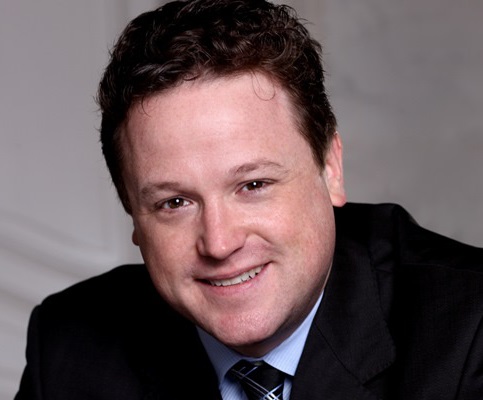

Franco Buitoni Award goes to Kurtág couple

On the occasion of György Kurtág’s 91th birthday – which is also the 70th wedding anniversary with Márta Kurtág – the couple have been presented with a Borletti-Buitoni Trust award (£30,000) in recognition of their distinguished contribution to the world of music, as well as their long and devoted musical partnership. This special tribute is in memory of Franco Buitoni (1934-2016) who co-founded the Borletti-Buitoni Trust (BBT) in 2002 with his wife, Ilaria.
Ilaria Borletti Buitoni, who travelled to Budapest with BBT trustee Mitsuko Uchida to present the award, said: "My husband, Franco, passed away last August. He and I founded BBT in 2002 to help talented young musicians develop their careers. From the very beginning we were pleased to have the artistic guidance and ideas of our founding trustee, Mitsuko Uchida, who was also a dear friend to Franco. I wanted to honour my husband's own lifetime of loving and supporting music with this special award and there seemed no better person to nominate a worthy recipient than Mitsuko."
Mitsuko Uchida commented: "Intense, mysterious, dark, otherworldly and innig; these are the words that come to my mind when I think of György Kurtág's music. He is inspirational and fiercely honest but there is also a deep love that glows through his music. This may be an expression of his extraordinary relationship with his wife, Márta. Anybody who has heard the Kurtágs play, four hands, would know what that means. We know György Kurtág the great composer but with him always is Márta the wonderful pianist. They live music together. Therefore, the special Franco Buitoni Award goes to György and Márta Kurtág. We are honoured that they have accepted this award on his 91st birthday and their 70th wedding anniversary. We have all been so lucky to have known them and their music, me especially."
Borletti Buitoni Trust presented its first awards in 2003 and, since then, has proudly supported more than 100 musicians and ensembles all over the world.Kurtág rehearsing his Beckett opera in progress
 György Kurtág, who now lives in Budapest Music Center is visited frequently by Arnaud Arbet, the musical assistant, and the singers of his opera Fin de partie planned to be premiered in 2018 in La Scala Milan. Kurtág helps with the preparations: he explains what the text means, he sings, he describes the connections between the notes, he talks about dinamics, articulation and stresses. He tells extraordinary things to the musicians, he sometimes reveals secrets about the work in progress, that one can only learn from him and his wife, Márta. The last time they rehearsed on 20 and 21 January with Frode Olsen and Leigh Melrose, playing Hamm and Clov. These two days of work was also documented on film. This time Pierre Audi was also present at the rehearsals.
György Kurtág, who now lives in Budapest Music Center is visited frequently by Arnaud Arbet, the musical assistant, and the singers of his opera Fin de partie planned to be premiered in 2018 in La Scala Milan. Kurtág helps with the preparations: he explains what the text means, he sings, he describes the connections between the notes, he talks about dinamics, articulation and stresses. He tells extraordinary things to the musicians, he sometimes reveals secrets about the work in progress, that one can only learn from him and his wife, Márta. The last time they rehearsed on 20 and 21 January with Frode Olsen and Leigh Melrose, playing Hamm and Clov. These two days of work was also documented on film. This time Pierre Audi was also present at the rehearsals.
Dusapin in Budapest

DialogScene is a special music theatre workshop announced by the Peter Eötvös Contemporary Music Foundation aiming to help young composers to produce contemporary duets for stage and give them an insight of how an opera can unfold from the first ideas of a libretto to the very last beat of a premiere.
In the first phase (8-13 February) participating composers will work on their duets with PASCAL DUSAPIN and PETER EÖTVÖS. The fellow professors will select five composers to be invited to return to Budapest for the second phase (4-15 September).
During the production phase five best duet-scenes of the workshop will be presented at Budapest Music Center staged by young directors of the University of Theatre and Film Arts. The young composers will also have the possibility to work closely with the singers, attend rehearsals and make compositional adjustments with the guidance of Peter Eötvös and Gergely Vajda.
The climax of DialogScene is the premiere of the five selected duet-scenes on the 15th of September 2017 at Budapest Music Center.
More ...In memoriam Kamilló Lendvay (1928-2016)

Composer Kamilló Lendvay passed away on 30 November 2016 at the age of 88. He was one of the most important members of the generation of Hungarian composers whose careers began in the 1950s. He studied composition with János Viski and conducting with László Somogyi at the Ferenc Liszt Academy of Music. After graduating he was the musical director of the State Puppet Theatre, and the Hungarian Army Art Ensemble, later he was a conductor and (from 1972) the musical director of the Budapest Operetta Theatre. In 1972 he was appointed teacher of music theory at the Academy of Music in Budapest, and as a head of Music Theory Department he retired from there in 1992. As a president of Artisjus, the president of Hungarian Composers’ Society he was actively involved in Hungarian music life.
His œuvre includes theatrical, oratorial, orchestral, chamber and solo instrumental works. In his music classical forms and genres have a significant role. Ideas gained from the works of the 20th-century Hungarian masters, together with abundant humour and many grotesque elements, are blended into an individual style in his works.
A significant part of Kamilló Lendvay’s works were published by Editio Musica Budapest; last Study for viola solo in February 2016.
His memory and his artistic legacy will be preserved forever.
Find more about his oeuvre here.
Dialogue with Mozart – A new work for orchestra by Péter Eötvös, premiered in Salzburg
 ‘In 2014, following an outstanding collaboration, I received a request from the Salzburg Mozarteum Orchestra, to write a new work for the 150th anniversary of the ensemble's formation. I felt honoured and, instead of a cake with 175 candles, I composed a cheerful piece using Mozart themes and taking into account the orchestra's virtuosic abilities. And the icing on the cake was that the premiere happens to be in Salzburg!’ – thus wrote Peter Eötvös about the origins of Dialogue with Mozart – Da Capo for orchestra. This new work is an orchestral transcription of da capo (mit Fragmenten aus W. A. Mozarts Fragmenten) composed in 2014 for cimbalom or marimba and chamber ensemble. It will be premiered on 15 December 2016 in Salzburg, conducted by Mirga Gražinyte-Tyla.
‘In 2014, following an outstanding collaboration, I received a request from the Salzburg Mozarteum Orchestra, to write a new work for the 150th anniversary of the ensemble's formation. I felt honoured and, instead of a cake with 175 candles, I composed a cheerful piece using Mozart themes and taking into account the orchestra's virtuosic abilities. And the icing on the cake was that the premiere happens to be in Salzburg!’ – thus wrote Peter Eötvös about the origins of Dialogue with Mozart – Da Capo for orchestra. This new work is an orchestral transcription of da capo (mit Fragmenten aus W. A. Mozarts Fragmenten) composed in 2014 for cimbalom or marimba and chamber ensemble. It will be premiered on 15 December 2016 in Salzburg, conducted by Mirga Gražinyte-Tyla.
ricordilab – Composer Competition 2016-2019

Ricordi Berlin has announced a brand new program, ricordilab, that will provide the opportunity for up to five emerging composers to participate in a three-year collaboration with our publishing house. ricordi berlin will publish selected works and provide international promotion for successful applicants and will also support the laureates with expertise in the music industry.
Festival in celebration of 90 years old György Kurtág
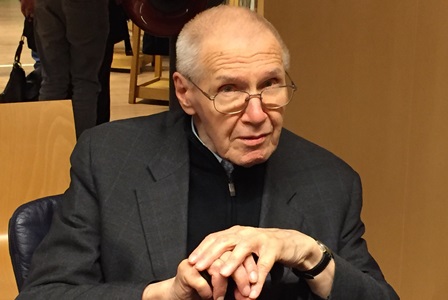 Budapest Music Center will celebrate the 90th birthday of György Kurtág with a grandiose festival between 14-21 February. The concert will present almost every part of the oeuvre, from the solo and chamber works to the choir and orchestral compositions. Apart from the original Kurtág pieces visitors will also have the chance to hear transcriptions of the piano pieces Játékok for chamber ensemble by Olivier Cuendet, the orchestral version of Zwiegespräch (originally composed for a string quartet and synthesizer), a program consisting of unpublished or barely known compositions and an homage concert of works by Kurtág contemporaries.
Budapest Music Center will celebrate the 90th birthday of György Kurtág with a grandiose festival between 14-21 February. The concert will present almost every part of the oeuvre, from the solo and chamber works to the choir and orchestral compositions. Apart from the original Kurtág pieces visitors will also have the chance to hear transcriptions of the piano pieces Játékok for chamber ensemble by Olivier Cuendet, the orchestral version of Zwiegespräch (originally composed for a string quartet and synthesizer), a program consisting of unpublished or barely known compositions and an homage concert of works by Kurtág contemporaries.
Most of the Hungarian and foreign performers taking part in the festival are former students of Kurtág or worldwide known performers of his work: Zoltán Kocsis, Gábor Csalog, András Keller, Péter Eötvös, Rácz Zoltán, Natalia Zagorinskaya, Juliane Banse, Pierre-Laurent Aimard. The concerts will be complemented by round-table discussions and lectures. A facsimile publication will be presented, the “Notebook for Kocsis Zoli” collected and copied from 1974 to 2006 by Kurtág himself for the Hungarian pianist Zoltán Kocsis, and a documentary film compiled by Judit Kurtág, the composer's grand-daughter, of footage filmed during a decade will be showed.
The primary locations of the events are the concert hall and library of BMC. The concert performed on February 19th, the composer's birthday, will take place at the Academy of Music, and the premiere of the previously mentioned documentary movie together with a concert will be hosted by the Palace of Arts.
Most valuable award for contemporary music goes to György Kurtág
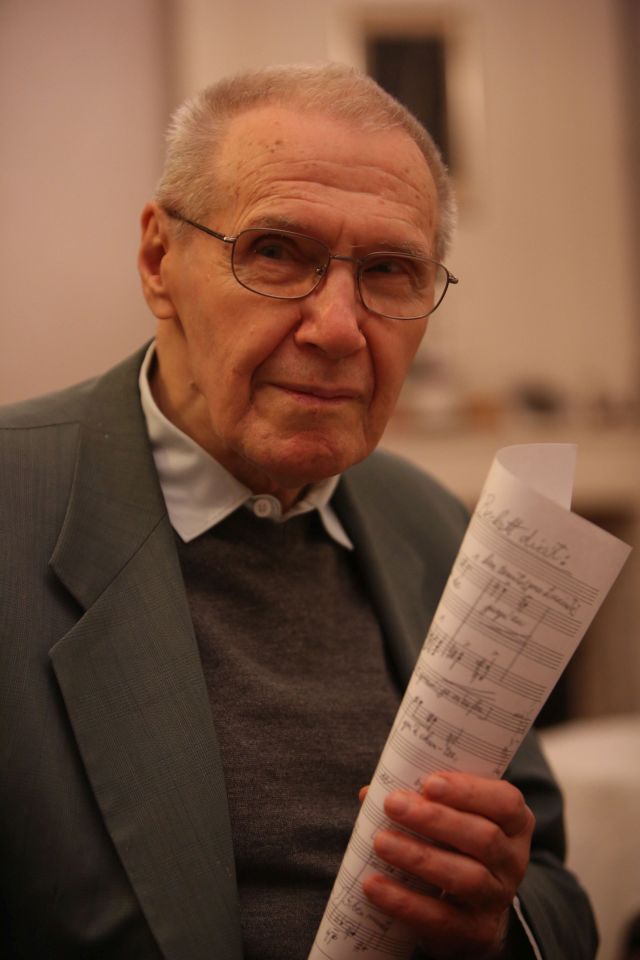 The 2014 BBVA Foundation Frontiers of Knowledge Award in the category of contemporary music was awarded to György Kurtág on February 10th, 2015. The renowned Hungarian composer was nominated by both the Ferenc Liszt Academy of Music and the Széchenyi Academy of Arts. The award is funded by the Spanish BBVA Foundation in order to promote and disseminate world-class scientific research and artistic creation. This honorable prize (worth 400,000€) was presented to Kurtág by the BBVA on June 23th, 2015. As the part of the celebrations (beside the orchestral works by Ravel and Berlioz) Kurtág's juvenile work Movement for viola and orchestra was performed by Philip Dukes and the Orquesta Sinfónica de Euskadi conducted by Jun Märkl.
The 2014 BBVA Foundation Frontiers of Knowledge Award in the category of contemporary music was awarded to György Kurtág on February 10th, 2015. The renowned Hungarian composer was nominated by both the Ferenc Liszt Academy of Music and the Széchenyi Academy of Arts. The award is funded by the Spanish BBVA Foundation in order to promote and disseminate world-class scientific research and artistic creation. This honorable prize (worth 400,000€) was presented to Kurtág by the BBVA on June 23th, 2015. As the part of the celebrations (beside the orchestral works by Ravel and Berlioz) Kurtág's juvenile work Movement for viola and orchestra was performed by Philip Dukes and the Orquesta Sinfónica de Euskadi conducted by Jun Märkl.
The jury in the contemporary music category stated that, "The novel dimension of Kurtág’s music lies not in the material he uses but in its spirit, the authenticity of its language, and the way it crosses borders between spontaneity and reflection, between formalism and expression." Additionally they are quoted as saying that Kurtág’s music, "…defies any system, accepts no compromise, and has traced a path independent from the mainstream. Today it stands as an alternative to a vision of history apparently confined to the opposition between innovation and a return to old models, between a music withdrawn into itself and a music that aims to communicate as broadly as possible."
The Foundation implements its programs in partnership with leading scientific and cultural organizations in Spain and abroad. It strives to prioritize those projects with the power to advance knowledge frontiers across the world. The BBVA Foundation established its Frontiers of Knowledge Awards in 2008 to recognize those who have made outstanding contributions in a broad range of scientific and technological fields while also representing cultural creativity at its expressive height in the area of music.
For more information, please visit the website of the Foundation.
Eight Invocations – World permiere and concert series
 Eight Invocations to the Lunar Phases, a cycle for viola and piano by László Tihanyi published in 2011 will be premiered by Kim Kashkashian és Péter Nagy in Florence’s Teatro della Pergola on 15th November, preceding the Hungarian premier by nine days. During the spring of 2015 the piece will be performed repeatedly in the United States, e. g. at such distinguished venues as the Morgan Library in New York or the Library of Congress in Washington DC where Béla Bartók and József Szigeti gave a recital in 1940.
Eight Invocations to the Lunar Phases, a cycle for viola and piano by László Tihanyi published in 2011 will be premiered by Kim Kashkashian és Péter Nagy in Florence’s Teatro della Pergola on 15th November, preceding the Hungarian premier by nine days. During the spring of 2015 the piece will be performed repeatedly in the United States, e. g. at such distinguished venues as the Morgan Library in New York or the Library of Congress in Washington DC where Béla Bartók and József Szigeti gave a recital in 1940.
 János Vajda (1949) has always been highly acclaimed for his vocal output. His Mario and the Magician and Leonce and Lena founded his fame as the leading Hungarian opera composer of the last decades. But his contribution to Latin sacred music is equally substantial, his Magnificat, Pater noster and Mass in B having been his main achievements so far.
János Vajda (1949) has always been highly acclaimed for his vocal output. His Mario and the Magician and Leonce and Lena founded his fame as the leading Hungarian opera composer of the last decades. But his contribution to Latin sacred music is equally substantial, his Magnificat, Pater noster and Mass in B having been his main achievements so far.
His Requiem for mixed choir and organ was composed in 2012 and premiered on 10th May 2014 by its dedicatees, the Canticum Novum Chamber Choir in Debrecen, directed by Ágnes Török. The piece has eight movements, and its peculiarity is that unlike Mozart but similarly to Fauré’s Requiem the piece does not include an Offertorium; however, Lux aeterna is followed by a Libera me and an In Paradisum movement. On the other hand, Vajda set to music the dramatic Medieval sequentia Dies irae, missing from Fauré’s Requiem. In any case, these differences are permitted by the flexibility of the liturgy.
As far as range or voice technique are concerned, this piece does not represent exraordinary requirements to the performers; from the point of view of intonation, it is reckoning on the abilities of a professional ensemble or an accomplished amateur choir. The composer is flexible not only in liturgical respects: the organ player is encouraged to alter the indicated registration depending on the instrument and the venue; and the solo sections are ad libitum in the sense that they can be sung by competent chorus members, by soloists from outside the chorus or, in the lack of capable soloists, they can also be allotted to the full choir.
But what is most important to mention: the dramatic and pictoresque qualities of the piece, the special attention paid to the subtleties of the text and the exceptional melodic invention give the piece an extraordinary expressive power. More than that, the variety of textures, sonorities and characters, the balanced structure of the work, so rich in contrasts, and, finally, its sensitive harmonic language exert a major impact on the listener from the very beginning.World premiere for Péter Eötvös on 6 May in Portugal
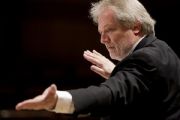 The work da capo for cimbalom and ensemble was composed in winter 2013-2014 at the invitation of Porto’s Casa da Musica, the Salzburg Internationale Stiftung Mozarteum and New World Symphony, America’s Orchestral Academy (Miami). The cimbalom solo was inspired by the performance of Hungarian cimbalom player Miklós Lukács.
The work da capo for cimbalom and ensemble was composed in winter 2013-2014 at the invitation of Porto’s Casa da Musica, the Salzburg Internationale Stiftung Mozarteum and New World Symphony, America’s Orchestral Academy (Miami). The cimbalom solo was inspired by the performance of Hungarian cimbalom player Miklós Lukács.
 As the subtitle of the piece (mit Fragmenten aus W. A. Mozart’s Fragmenten) indicates the initial tunes come from Mozart’s notebooks. Eötvös presents these tunes to listeners in a clearly recognisable way, but he immediately develops and transforms them. Mozart’s themes are remodelled in the chamber ensemble, the instruments of which were still unknown in the 18th century, and the musical journey is made especially adventurous in that the solo (can be performed also the marimba) is presented by a musical instrument which cannot have been used in the 18th century.
As the subtitle of the piece (mit Fragmenten aus W. A. Mozart’s Fragmenten) indicates the initial tunes come from Mozart’s notebooks. Eötvös presents these tunes to listeners in a clearly recognisable way, but he immediately develops and transforms them. Mozart’s themes are remodelled in the chamber ensemble, the instruments of which were still unknown in the 18th century, and the musical journey is made especially adventurous in that the solo (can be performed also the marimba) is presented by a musical instrument which cannot have been used in the 18th century.
Da capo be premiered at the Sala Suggia of Casa da Musica at Porto. The soloist will be Miklós Lukács, the Remix Ensemble will be conducted by the composer.
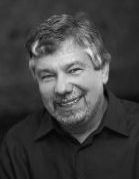 The concerto was composed in 2012, inspired by István Várdai’s play and is dedicated to him. The triple movement structure and the character of the movements follow the patterns of classical concertos, while the thematic connections spanning the movements rather reflect the structural principles of Romantic symphonies.
The concerto was composed in 2012, inspired by István Várdai’s play and is dedicated to him. The triple movement structure and the character of the movements follow the patterns of classical concertos, while the thematic connections spanning the movements rather reflect the structural principles of Romantic symphonies.
It will be premiered on March 29 at the Grand Hall of Liszt Academy in Budapest. The soloist will be István Várdai, the Zugló Philharmonics Orchestra will be conducted by György Vashegyi.
More about the concert.

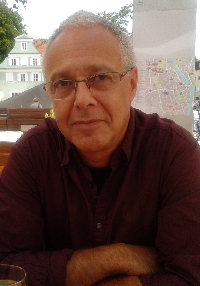 Ensemble arTrium (Steffi Mölle – flute, Odile Skarnes – viola, Zsuzsanna Aba-Nagy – harp) gives the Austrian premiere of Symmetry-Asymmetry by Balázs Horváth at the Alte Schmiede in Vienna on March 19.
Ensemble arTrium (Steffi Mölle – flute, Odile Skarnes – viola, Zsuzsanna Aba-Nagy – harp) gives the Austrian premiere of Symmetry-Asymmetry by Balázs Horváth at the Alte Schmiede in Vienna on March 19.
More about the concert...
THReNSeMBle also performes pieces by Marcell Dargay, Péter Tornyai, Rafal Zapala and Pierre Boulez.Waiting for... by balázs Horváth and Summer Music by László Tihanyi will be premiered in Poland by THReNSeMBle and Balázs Horváth at the 43. Poznańska wiosna muzyczna, Poznań Festival on 22 March.
More about the concert and the festival...
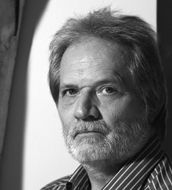
 Péter Eötvös celebrated his 70th birthday on 2 January while László Vidovszky will be 70 on 25 February. The careers of the two composers are connected at several points, given their coinciding years of studies and the beginning of their careers, and also their joint work in the Budapest New Music Studio, their friendship and mutual friends.
Péter Eötvös celebrated his 70th birthday on 2 January while László Vidovszky will be 70 on 25 February. The careers of the two composers are connected at several points, given their coinciding years of studies and the beginning of their careers, and also their joint work in the Budapest New Music Studio, their friendship and mutual friends. Kurtág’s Troussova cycle included in curriculum
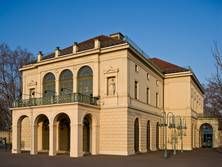 This winter term the curriculum of the Opera School of the Hochschule für Musik und Darstellende Kunst Stuttgart included György Kurtág’s song cycle Messages of the Late Miss R. V. Troussova and Alexander von Zemlinsky’s chamber opera Der Zwerg. To mark the end of term they will be performed for the public on five occasions at the Wilhelma Theater between 8 and 16 February. The lead part in Kurtág’s work will be sung by the students divided according to the three parts of the cycle. The story on stage woven round the cycle focusses on passion, futile yearning and hopelessness expressed in music and verse. The instrumental parts will be played by the chamber orchestra of the college.
This winter term the curriculum of the Opera School of the Hochschule für Musik und Darstellende Kunst Stuttgart included György Kurtág’s song cycle Messages of the Late Miss R. V. Troussova and Alexander von Zemlinsky’s chamber opera Der Zwerg. To mark the end of term they will be performed for the public on five occasions at the Wilhelma Theater between 8 and 16 February. The lead part in Kurtág’s work will be sung by the students divided according to the three parts of the cycle. The story on stage woven round the cycle focusses on passion, futile yearning and hopelessness expressed in music and verse. The instrumental parts will be played by the chamber orchestra of the college.  The chairman of the Royal Philharmonic Society, John Gilhooly, described the concert given by György and Márta Kurtág in London’s Queen Elizabeth Hall on 1 December as a significant event in music history. In the first half of the recital Hiromi Kikuchi performed the eight-movement Hipartita for solo violin, which the composer had dedicated to the musician. After the interval, György and Márta Kurtág played a selection of solo and four-handed pieces from Games and Kurtág’s Bach transcriptions. Compositions which had originally been written as a homage, gift or message in sounds to colleagues and friends featured significantly in the ‘composed ’ programme that was performed without intermission. The Kurtágs played on an upright piano with the ‘quiet’ pedal always depressed. The instrument’s sound was amplified only to the extent that in the jam-packed hall accommodating 900 people everyone would feel the intensity of the soft sounds and could enter the magic world revealed by the playing of the two exceptional musicians. Their performance and the encore, a four-handed Schumann piece, received a standing ovation.
The chairman of the Royal Philharmonic Society, John Gilhooly, described the concert given by György and Márta Kurtág in London’s Queen Elizabeth Hall on 1 December as a significant event in music history. In the first half of the recital Hiromi Kikuchi performed the eight-movement Hipartita for solo violin, which the composer had dedicated to the musician. After the interval, György and Márta Kurtág played a selection of solo and four-handed pieces from Games and Kurtág’s Bach transcriptions. Compositions which had originally been written as a homage, gift or message in sounds to colleagues and friends featured significantly in the ‘composed ’ programme that was performed without intermission. The Kurtágs played on an upright piano with the ‘quiet’ pedal always depressed. The instrument’s sound was amplified only to the extent that in the jam-packed hall accommodating 900 people everyone would feel the intensity of the soft sounds and could enter the magic world revealed by the playing of the two exceptional musicians. Their performance and the encore, a four-handed Schumann piece, received a standing ovation.
At the end of the concert György Kurtág was presented with the Gold Medal of the Royal Philharmonic Society, its highest honour which has been awarded to the most significant composers and performers of the music world for 143 years, ever since the centenary of Beethoven’s birth. From the time the society was founded contemporary music has been given distinguished attention, due to which numerous significant works were commissioned by the RPS, including Beethoven’s 9th Symphony. Earlier gold medallists include Brahms, Britten, Sibelius, Walton, Prokofiev, Rachmaninov, Richard Strauss, Stravinsky, Messiaen, Lutosławski and György Ligeti. On receiving the medal, Kurtág responded with music after some brief words of thanks for the award. He and Márta played Mozart’s four-handed Variations in G major (K. 501) which the audience again received with an ovation.
Kurtág's music at the gala concert of the Berlin Philharmonic
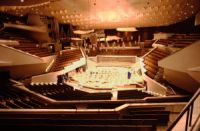 The concert hall of the Berliner Philharmonic, designed by Hans Scharoun and noted for its unique architecture, opened 50 years ago. On 20 October the anniversary is being celebrated by a gala concert with a programme that features compositions filling musical space in a special way.
The concert hall of the Berliner Philharmonic, designed by Hans Scharoun and noted for its unique architecture, opened 50 years ago. On 20 October the anniversary is being celebrated by a gala concert with a programme that features compositions filling musical space in a special way.Zoltán Jeney - portrait concerts in Sweden

Kocsár, Láng, Dubrovay, Jeney - Anniversaries and Premieres - Budapest Music of Our Age, 2013
 The programme of the Budapest Music of Our Age Festival, being held for the 39th time this year, focuses on anniversaries of Polish and Hungarian composers. Besides works by Witold Lutosławski, born a century ago, and György Ligeti born 90 years ago, compositions by Krzysztof Penderecki and Henryk Górecki, who are celebrating their 80th birthdays this year, the 80-year-old Miklós Kocsár and István Láng, as well as the 70-year-old László Dubrovay and Zoltán Jeney, are being presented either for the first time in Hungary or in the world. The concert of the Qaartsiluni Ensemble and the Rondino Chamber Orchestra will be devoted to György Ligeti’s works and compositions dedicated to him. Former and new choir work by Miklós Kocsár will be performed by the Angelica Girls’ Choir, and István Láng’s compositions will be heard at the concert of the EAR Ensemble. László Dubrovay is being celebrated with a full orchestral evening. The MÁV Symphony Orchestra will perform his Spring Symphony and Violin Concerto No. 2, which has recently been published by Editio Musica Budapest. Zoltán Jeney’s special composer’s evening comprises solo and chamber pieces which he dedicated to individuals and fellow composers who had a determining influence on his career. Such are the Heraclitus Cycle, based on poems by Dezső Tandori, Meditazione sur un tema di Petrassi for piano and Farewell to György Ligeti, composed for the cimbalom. The concert will also include the premiere of his recently completed Agony song cycle created for György Petri’s poems.
The programme of the Budapest Music of Our Age Festival, being held for the 39th time this year, focuses on anniversaries of Polish and Hungarian composers. Besides works by Witold Lutosławski, born a century ago, and György Ligeti born 90 years ago, compositions by Krzysztof Penderecki and Henryk Górecki, who are celebrating their 80th birthdays this year, the 80-year-old Miklós Kocsár and István Láng, as well as the 70-year-old László Dubrovay and Zoltán Jeney, are being presented either for the first time in Hungary or in the world. The concert of the Qaartsiluni Ensemble and the Rondino Chamber Orchestra will be devoted to György Ligeti’s works and compositions dedicated to him. Former and new choir work by Miklós Kocsár will be performed by the Angelica Girls’ Choir, and István Láng’s compositions will be heard at the concert of the EAR Ensemble. László Dubrovay is being celebrated with a full orchestral evening. The MÁV Symphony Orchestra will perform his Spring Symphony and Violin Concerto No. 2, which has recently been published by Editio Musica Budapest. Zoltán Jeney’s special composer’s evening comprises solo and chamber pieces which he dedicated to individuals and fellow composers who had a determining influence on his career. Such are the Heraclitus Cycle, based on poems by Dezső Tandori, Meditazione sur un tema di Petrassi for piano and Farewell to György Ligeti, composed for the cimbalom. The concert will also include the premiere of his recently completed Agony song cycle created for György Petri’s poems. Gyula Dávid, one of the most important representatives of the generation following Bartók and Kodály, was born on
Gyula Dávid, one of the most important representatives of the generation following Bartók and Kodály, was born on
Viola Works by Kurtág and Ligeti on Kim Kashkashian's Grammy awarded CD
 Kim Kashkashian won the Grammy Award for Best Classical Instrumental Solo with her Kurtág/Ligeti album titled Music for Viola.
Kim Kashkashian won the Grammy Award for Best Classical Instrumental Solo with her Kurtág/Ligeti album titled Music for Viola.The american-armenian viola master has devoted herself principally to the Hungarian composer György Kurtág's works for the last twenty years. As Joshua Kosman wrote: „It's a terrific pairing of two linked but complementary sensibilities, matching Kurtág's terse, aphoristic style with Ligeti's more expansive and playful creative personality."
We are proud to be the publisher of the celebrated contemporary composer György Kurtág's ouvre including the collection entitled "Signes, Games and Messages for Viola" performed on the Grammy awarded CD.
György Kurtág's Wihuri Sibelius Prize

Chamber opera workshop for composers on Sławomir Mrożek’s play entitled ‘Out at Sea’
 A Chamber Opera Workshop is being organized for young composers by the Peter Eötvös Contemporary Music Foundation in 2013 to produce a jointly created opera on Sławomir Mrożek’s absurd one-act play entitled ‘Out at Sea’, which unites and addresses the predominant phenomena of the modern age (alienation, abuse of power, conformity and the question of the boundaries of freedom) in one grotesque situation, and in which the problem of part-whole relations is reflected in the possibilities of form and technique.
A Chamber Opera Workshop is being organized for young composers by the Peter Eötvös Contemporary Music Foundation in 2013 to produce a jointly created opera on Sławomir Mrożek’s absurd one-act play entitled ‘Out at Sea’, which unites and addresses the predominant phenomena of the modern age (alienation, abuse of power, conformity and the question of the boundaries of freedom) in one grotesque situation, and in which the problem of part-whole relations is reflected in the possibilities of form and technique.
In April 2013 the applicants will take part in a four-day workshop where the teamwork – supervised and guided by Péter Eötvös and Luca Francesconi – will consist of discussing and deciding among the special potential options offered by the libretto, dramaturgy and composition technique. The chamber opera is to be composed for three singers and four instruments to accompany them. Without any alteration in the libretto based on Mrożek’s play written by András Almási-Tóth, each character will be created by a different
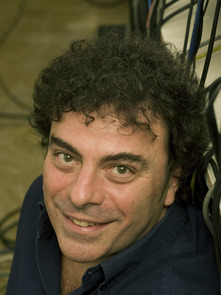
composer in accordance with the agreements reached during the workshop. After approximately one month of independent work and ongoing consultation with the assistant professor Balázs Horváth, the composition drafts have to be submitted. In May, after reviewing these materials the professors will select six composers who are to finish their compositions by the end of August 2013.
The final scores will be published by Editio Musica Budapest. The premiere will be held on December 19, 2013 in the concert hall of the new Budapest Music Center building under the direction of Péter Eötvös and conducted by Hsiao-Lin Liao. The opera will be performed in several other European cities including Paris, Milan, Brussels and Riga in the course of 2014. The workshop and the performances will be supported by the Art Mentor Foundation Lucerne and the Ulysses Network.
Four hand piano recital of Márta and György Kurtág in Paris
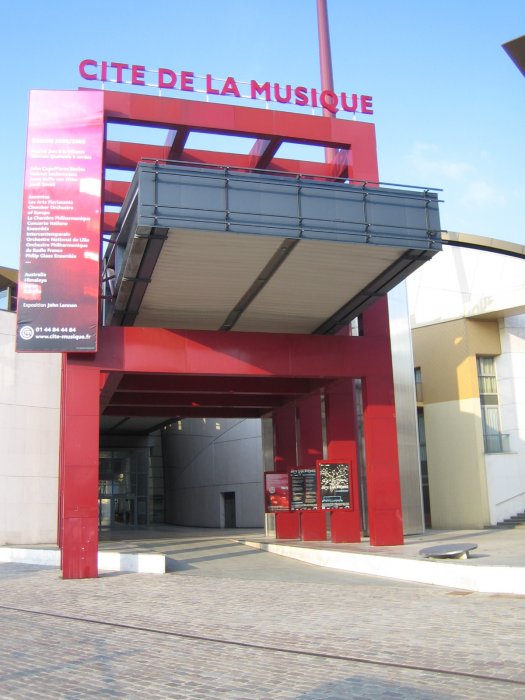
BACH/KURTÁG - GYÖRGY KURTÁG, LE JEU DE LA MUSIQUE - Concerts, conference and master course in Paris
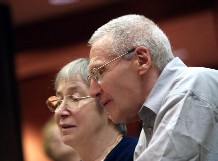 In György Kurtág’s works tradition is not just processed or incorporated experience, but much more than that: constant inspiration, often acknowledged even in the titles, that together with his individual voice and personality has already made his music a classical example of contemporary music.
In György Kurtág’s works tradition is not just processed or incorporated experience, but much more than that: constant inspiration, often acknowledged even in the titles, that together with his individual voice and personality has already made his music a classical example of contemporary music.
Between September 19th and 26th a week of concerts and musicology lectures in the Cité de
Hungarian chamber music at Kempten in Germany
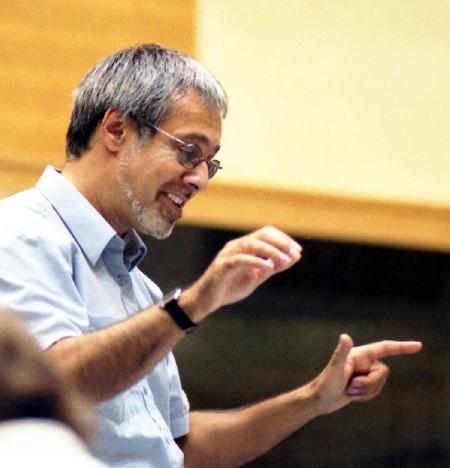 This autumn László Tihanyi is the composer in residence at the 7. Kempten Internationales Festival der Kammermusik. In the framework of the week-long series of concerts four of his works will be performed, including the première of Rundherum, for piano and string quartet, commissioned by the festival. The title refers to the arrangement on the platform of the instruments and music stands, and to the movement of the players. Tihanyi, few of whose works have so far been composed for traditional chamber music groups, has not written a classical-romantic type of piano quintet this time either. In it the pianist and the members of the string quartet also play on percussion instruments and mouth organs.
This autumn László Tihanyi is the composer in residence at the 7. Kempten Internationales Festival der Kammermusik. In the framework of the week-long series of concerts four of his works will be performed, including the première of Rundherum, for piano and string quartet, commissioned by the festival. The title refers to the arrangement on the platform of the instruments and music stands, and to the movement of the players. Tihanyi, few of whose works have so far been composed for traditional chamber music groups, has not written a classical-romantic type of piano quintet this time either. In it the pianist and the members of the string quartet also play on percussion instruments and mouth organs.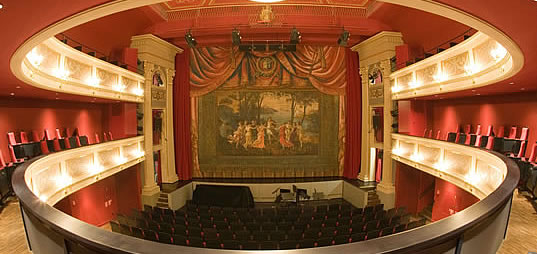 At Kempten every year the focus is on a different country’s chamber music; mainly 20th-century and contemporary works are played, or curiosities from earlier periods. This year there is a rich selection of Hungarian works: through compositions by 22 composers – including Liszt, Bartók, Kodály, Dohnányi, Leó Weiner, Mátyás Seiber, Ferenc Farkas, György Ránki, György Kurtág, György Ligeti, György Orbán, Miklós Kocsár, Péter Eötvös, Zoltán Jeney, László Tihanyi and others – the traditions and modern forms of Hungarian chamber music will be displayed.
At Kempten every year the focus is on a different country’s chamber music; mainly 20th-century and contemporary works are played, or curiosities from earlier periods. This year there is a rich selection of Hungarian works: through compositions by 22 composers – including Liszt, Bartók, Kodály, Dohnányi, Leó Weiner, Mátyás Seiber, Ferenc Farkas, György Ránki, György Kurtág, György Ligeti, György Orbán, Miklós Kocsár, Péter Eötvös, Zoltán Jeney, László Tihanyi and others – the traditions and modern forms of Hungarian chamber music will be displayed.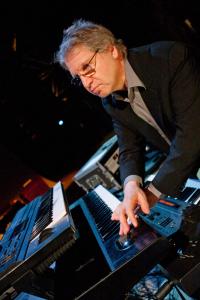 "We have been working on it for eight years and perhaps we will never finish. The aim is, after all, to continue the dialogue between us." So wrote György Kurtág, Jr. on his and his father's joint composition Zwiegespräch in 2007. This piece, originally composed for string quartet and synthesizer, represents an extraordinary cooperation: a dialogue between two different artists, two generations and also between the sounds of tradition and new technologies.
"We have been working on it for eight years and perhaps we will never finish. The aim is, after all, to continue the dialogue between us." So wrote György Kurtág, Jr. on his and his father's joint composition Zwiegespräch in 2007. This piece, originally composed for string quartet and synthesizer, represents an extraordinary cooperation: a dialogue between two different artists, two generations and also between the sounds of tradition and new technologies. After rearranging the quartet parts for chamber ensemble in 2011 (this version was performed several times by the Ensemble baBel and György Kurtág, Jr.) the Swiss conductor OLIVIER CUENDET created an orchestral version with four movements. This brand new version, comprised of Tears, Love Song, Müezzin and Solace, will be premiered by the MÁV Symphony Orchestra and György Kurtág, Jr. conducted by Gábor Takács-Nagy on May 16 in Budapest.
World premiere for Kurtág in Geneva - Brefs Messages op. 47
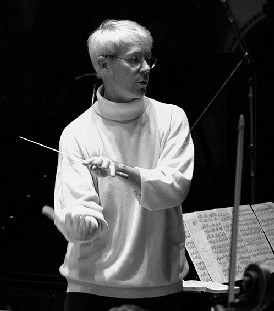 György Kurtág’s recently finished work for nine instruments is performed by Ensemble Contrechamps on the 1st November together with the string quartet Officium breve in memoriam Andeae Szervánszky and works by Sándor Veress and the Swiss composer Roland Moser. The Brefs Messages op. 47 was commissioned by Contrechamps and dedicated to this ensemble and the conductor of the premiere Olivier Cuendet. Its first movement (Fanfare) is written directly to Cuendet, the second one (Versetto: Temptavit Deus Abraham - apokrif organum) is dedicated to the Hungarian musicologist László Dobszay. As often in Kurtág’s practice the third and fourth movements are scored version of earlier instrumental pieces: the former one (Ligatura Y) is originally a part of Games for piano, the latter one (Bornemisza: Az hit …) comes from the Sayings of Péter Bornemisza op. 7. The composition has been still opened as Kurtág plans to add more movements further on.
György Kurtág’s recently finished work for nine instruments is performed by Ensemble Contrechamps on the 1st November together with the string quartet Officium breve in memoriam Andeae Szervánszky and works by Sándor Veress and the Swiss composer Roland Moser. The Brefs Messages op. 47 was commissioned by Contrechamps and dedicated to this ensemble and the conductor of the premiere Olivier Cuendet. Its first movement (Fanfare) is written directly to Cuendet, the second one (Versetto: Temptavit Deus Abraham - apokrif organum) is dedicated to the Hungarian musicologist László Dobszay. As often in Kurtág’s practice the third and fourth movements are scored version of earlier instrumental pieces: the former one (Ligatura Y) is originally a part of Games for piano, the latter one (Bornemisza: Az hit …) comes from the Sayings of Péter Bornemisza op. 7. The composition has been still opened as Kurtág plans to add more movements further on.
GAMES and ZWIEGESPRÄCH in new instrumentation
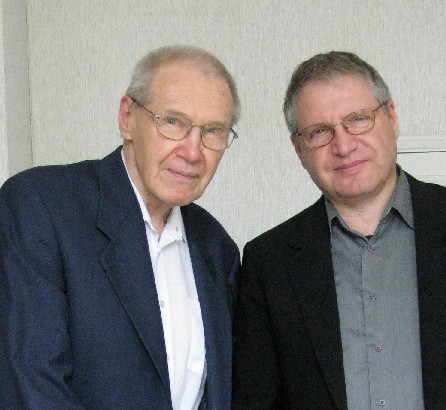
Also, the concert is the cooperation of the two rather different artists, father and son, which resulted in a piece composed as a joint work for string-quartet and synthesizer called the Zwiegespräch. This is how Kurtag Jr. reflected upon the birth of this piece in 2007:
While working on it, I realised how differently my father and I think. The fact that we do not hear the same thing initially caused misunderstandings, but when we realised it, we were able to ask one another: what do you hear?
It is impossible to unravel who has done what in this piece, which changes from performance to performance: today there isn’t one note in common with those played at the first concert. We have been working on it for eight years, and perhaps we will never finish. The aim is, after all, to continue the dialogue between us.
At the Budapest concert there is another composer joining the Kurtágs, so the Games – originally composed for piano - and the Zwiegespräch will be performed by a chamber orchestra in the instrumentation of Olivier Cuendet, the Art Director of Ensemble Babel.
Three questions for sixty-five composers
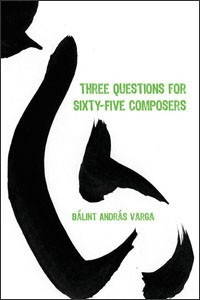
Balázs Horváth’s Faust Groteske - First Austrian performance at Musikprotokoll Graz
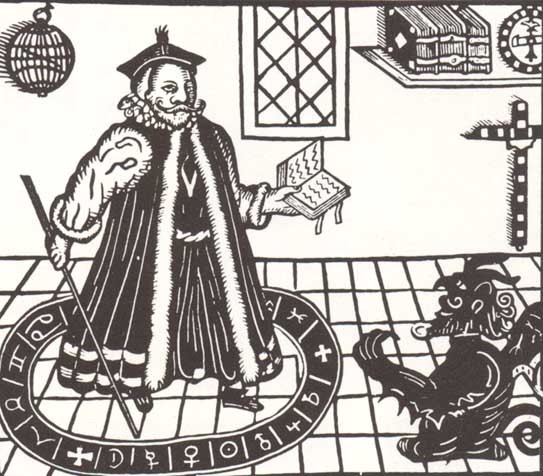 Five compositions will be performed by the Vienna ORF Radio Symphony Orchestra conducted by Péter Eötvös on 8 October. The program is on the one hand dedicated to Ferenc Liszt who was born 200 years ago and on the other hand presents the prize winners of the Gustav Mahler Composition Competition and the Hungarian Music Forum.
Five compositions will be performed by the Vienna ORF Radio Symphony Orchestra conducted by Péter Eötvös on 8 October. The program is on the one hand dedicated to Ferenc Liszt who was born 200 years ago and on the other hand presents the prize winners of the Gustav Mahler Composition Competition and the Hungarian Music Forum. World premiere for László Vidovszky - Reverb in Weimar
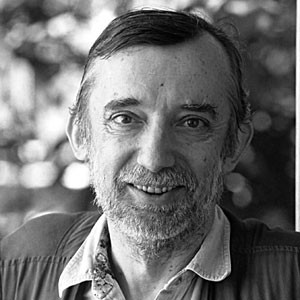
PIERRE-LAURENT AIMARD and KLANGFORUM WIEN perform László Vidovszky's Reverb on 27 August in the program of Kunstfest Weimar. The work for piano and string quartet was comissioned as a part of the project „Visions" - a hommage to Franz Liszt.
Celebrating Liszt's 200th birthday Kunstfest Weimar comissioned seven new compositions by composers representing the seven most important countries in Liszt's life and work: Switzerland, France, Germany, Italy, Hungary, Austria and Russia.
“Zeichen, Spiele, Botschaften” – Kurtág portrait concerts in the programme of the Schwetzingen Festival
 Between May 19th and 21st, solo and chamber works by György Kurtág will be performed at five concerts in Schwetzingen Castle near Heidelberg, which has for six decades traditionally provided a venue for early and modern music. Featuring in the programme are the string and wind movements of Signs, Games and Messages; the Messages of the Late R.V. Troussova; the Twelve Microludien; the Officium breve in memoriam Andreae Szervánszky; the Kafka-Fragmente; excerpts from the Series of Games written for piano; and Hommage à Robert Schumann, together with chamber works by Schönberg, Bach, Beethoven, Mozart and Schumann – emphasizing the close relationship between the art of Kurtág and classical chamber music. Kurtág’s music will be interpreted by the most outstanding performers of the composer’s works, including Juliane Banse, András Keller, Tabea Zimmermann, Heinz Holliger, Jörg Widmann, Dénes Várjon, the Collegium Novum Zürich and the Hagen Quartet.
Between May 19th and 21st, solo and chamber works by György Kurtág will be performed at five concerts in Schwetzingen Castle near Heidelberg, which has for six decades traditionally provided a venue for early and modern music. Featuring in the programme are the string and wind movements of Signs, Games and Messages; the Messages of the Late R.V. Troussova; the Twelve Microludien; the Officium breve in memoriam Andreae Szervánszky; the Kafka-Fragmente; excerpts from the Series of Games written for piano; and Hommage à Robert Schumann, together with chamber works by Schönberg, Bach, Beethoven, Mozart and Schumann – emphasizing the close relationship between the art of Kurtág and classical chamber music. Kurtág’s music will be interpreted by the most outstanding performers of the composer’s works, including Juliane Banse, András Keller, Tabea Zimmermann, Heinz Holliger, Jörg Widmann, Dénes Várjon, the Collegium Novum Zürich and the Hagen Quartet. Balázs Horváth’s Divergent for trumpet and big band is performed by Croatian Radio Television Big Band conducted by Saša Nestorović on
Balázs Horváth’s Divergent for trumpet and big band is performed by Croatian Radio Television Big Band conducted by Saša Nestorović on
13 April, organised by ISCM World New Music Days and Zagreb Biennale.
THReNSeMBle at the Gaudeamus Competition
 THReNSeMBle (Artistic leader: Balázs Horváth) will participate at the Gaudeamus Interpreters Competition in Amsterdam. Beside the works of Franco Donatoni, Theo Lovendie, Pierre Boulez and Yannis Kyriakides will be played Péter Tornyai’s Abfall-Musik, Zoltán Jeney’s Self-quotations, Balázs Horváth’s Waiting for... and László Tihanyi’s Summer Music.
THReNSeMBle (Artistic leader: Balázs Horváth) will participate at the Gaudeamus Interpreters Competition in Amsterdam. Beside the works of Franco Donatoni, Theo Lovendie, Pierre Boulez and Yannis Kyriakides will be played Péter Tornyai’s Abfall-Musik, Zoltán Jeney’s Self-quotations, Balázs Horváth’s Waiting for... and László Tihanyi’s Summer Music.
The program of the competition is also performed in Budapest on 31 March and 4 April.
György Kurtág celebrated in Neue Zeitschrift für Musik
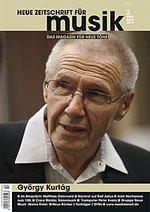 The recent issue of Neue Zeitschrift für Musik (2011/2) is devoted to the music of György Kurtág celebrating his 85th birthday with articles and studies by Gösta Neuwirth, Rainer Nonnenmann, Hartmut Lück, Stefan Drees and Philipp Brüllmann.
The recent issue of Neue Zeitschrift für Musik (2011/2) is devoted to the music of György Kurtág celebrating his 85th birthday with articles and studies by Gösta Neuwirth, Rainer Nonnenmann, Hartmut Lück, Stefan Drees and Philipp Brüllmann.
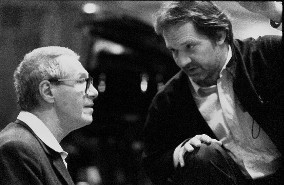 To celebrate György Kurtág’s 85th birthday a gala concert was held on February 20th in Budapest, in the Palace of Arts. The concert programme included both chamber music and orchestral works: Four Akhmatova Poems and Messages of the late Miss R. V. Troussova were performed by Natalia Zagorinskaya and the UMZE Ensemble conducted by Péter Eötvös; Grabstein für Stefan, Op.27No.2 (Double Concerto) and Stele were played by the Concerto Budapest Orchestra conducted by András Keller. The soloists in the orchestral works were Elena Casoli (guitar), Gábor Csalog (piano) and Nicolas Altstaedt (cello).
To celebrate György Kurtág’s 85th birthday a gala concert was held on February 20th in Budapest, in the Palace of Arts. The concert programme included both chamber music and orchestral works: Four Akhmatova Poems and Messages of the late Miss R. V. Troussova were performed by Natalia Zagorinskaya and the UMZE Ensemble conducted by Péter Eötvös; Grabstein für Stefan, Op.27No.2 (Double Concerto) and Stele were played by the Concerto Budapest Orchestra conducted by András Keller. The soloists in the orchestral works were Elena Casoli (guitar), Gábor Csalog (piano) and Nicolas Altstaedt (cello).
Before this concert Gábor Csalog – a former pupil of Kurtág, and one of the most authentic performers of his piano works – with his own pupils and the Ludium chamber ensemble had performed extracts from Games and the series Signs, Games, Messages and from Kurtág’s most recently completed works for piano.
New Hungarian Music Forum 2011 - Composers Competition

At a press conference on January 20th the results of the first round of the 2011 New Hungarian Music Forum were announced. Eight works ( four chamber and four orchestral pieces) by seven young Hungarian composers (Marcell DARGAY, Balázs HORVÁTH, László SÁNDOR, Péter TORNYAI, Árpád SOLTI, Judit VARGA and Ákos ZARÁNDY) reached the final, which will take the form of a public gala concert to be given on February 8th, 2011 in the Palace of Arts, Budapest. The chamber works will be presented by the UMZE Chamber Ensemble, and the orchestral pieces by the Concerto Budapest Orchestra conducted by Zoltán Rácz and András Keller. There and then the jury will decide on and announce the order of the prizes.
The competition is organized by the BUDAPEST MUSIC CENTER and the PALACE OF ARTS, with the support of the Hungarofest Klassz Zenei Iroda. The organizers wish to pay tribute this year to Ferenc Liszt, who was born 200 years ago; they therefore required the composers to submit works with themes inspired by Liszt's art.
The three prizes in each of the two categories, works for orchestra and for chamber ensemble respectively, have been donated by the Hungarian Intellectual Property Office. As an additional prize, Editio Musica Budapest has undertaken to publish the eight works presented in the final, and to promote them abroad; the Fidelio internet portal has offered valuable media space, and the Ferenc Liszt Music University will organize an individual evening concert featuring one of the finalists. The Budapest Music Center is going to issue as a promotional record the programme of the final, the gala concert.












